

Qué es el Desk Research y cómo aplicarlo en tus procesos de investigación

En un entorno empresarial cada vez más competitivo, la investigación es clave para minimizar riesgos y tomar decisiones acertadas. Sin embargo, esto puede resultar un auténtico desafío para las empresas con recursos limitados. Aquí es donde el Desk Research se convierte en una herramienta especialmente útil para empresas que buscan datos relevantes sin desembolsar una gran cantidad de dinero. Al aprovechar fuentes de libre y fácil acceso, esta técnica permite recopilar y aplicar datos esenciales para la toma de decisiones.
En este artículo, te explicamos qué es el Desk Research , cómo utilizarlo en tus procesos de investigación y sus ventajas para aprovechar al máximo esta valiosa técnica.
¿Qué es el Desk Research?
El Desk Research, también conocido como investigación secundaria o investigación de escritorio, es un tipo de investigación que se basa en fuentes de información publicadas en sitios webs, informes, libros, artículos, estadísticas, bases de datos, etc.
El objetivo del Desk Research es recabar información relevante sobre el tema que se quiere investigar, sin tener que generar nuevos datos mediante la investigación primaria (entrevistas, observaciones, encuestas, etc.). El Desk Research permite obtener una visión general del contexto, el mercado, la competencia, las tendencias y las oportunidades relacionadas con el problema o la oportunidad que se quiere abordar.
Además, el Desk Research es una técnica que se puede aplicar en cualquier fase del proceso de investigación, desde la definición del problema hasta la evaluación de las soluciones. Sin embargo, se suele aplicar en las primeras etapas, cuando se necesita obtener una comprensión amplia del tema y establecer los objetivos y las preguntas de investigación.
Desk Research : ejemplos de fuentes de investigación
- Búsqueda en internet: una de las formas más accesibles y efectivas de realizar un Desk Research es mediante la búsqueda en Internet. Los datos disponibles en línea están al alcance de un clic, y a menudo son gratuitos o de bajo costo. Eso sí, identifica fuentes verídicas para asegurarte la fiabilidad de los datos recopilados.
- Agencias gubernamentales y no gubernamentales : otra fuente esencial para el Desk Research son las agencias gubernamentales y no gubernamentales. Estas instituciones albergan una gran cantidad de datos valiosos y relevantes que pueden ser aprovechados por las empresas en su investigación.
- Bibliotecas y repositorios : las bibliotecas públicas, tanto físicas como digitales juegan un papel esencial en la investigación de escritorio. Al explorar archivos de investigaciones previas, estadísticas y boletines informativos, las empresas pueden identificar tendencias en el mercado.
- Instituciones educativas: este tipo de fuentes es muy valiosa para el Desk Research. Las empresas pueden colaborar con estas instituciones para acceder a datos relevantes.
- Fuentes comerciales: Los periódicos o revistas proporcionan información de primera mano sobre la actualidad económica, política y de mercado. Estas fuentes son una mina de datos valiosos que pueden impulsar tu Desk Research.
¿Cómo utilizar el Desk Research en tu investigación? 5 pasos a seguir

Para llevar a cabo un Desk Research, sigue los siguientes pasos:
- Identifica el tema: antes de adentrarte en la investigación, es vital identificar el tema. Haz una lista detallada de los atributos que serán investigados y define el propósito del Desk Research.
- Selecciona fuentes relevantes: en la actualidad, Internet ofrece una gran cantidad de información, pero evaluar y filtrar las fuentes de referencia es crucial para garantizar su autenticidad. Elige fuentes fiables para recopilar datos significativos. Consulta informes gubernamentales, actas de congresos, publicaciones periódicas y otras fuentes relevantes, por ejemplo, el Instituto Nacional de Estadística (INE) .
- Recopilación de datos : una vez que hayas identificado las fuentes de información, realiza una búsqueda minuciosa de datos previos relacionados con el tema. Examina registros y datos anteriores disponibles en diferentes fuentes, como bibliotecas, organismos gubernamentales y otras entidades oficiales.
- Combinación y comparación : combinar y comparar los datos recopilados te ayudará a optimizar la eficiencia de la investigación y evitar la repetición innecesaria del análisis. Utiliza estrategias como las «tarjetas de Insights» para sintetizar y resumir la información relevante.
- Análisis: el análisis de datos es el núcleo del Desk Research. Aquí, todos los pasos anteriores cobran sentido al confirmar si se han abordado todas las preguntas planteadas inicialmente. Si surgen lagunas, repite el proceso para profundizar en conceptos clave.
Ventajas de utilizar un Desk Research
Esta técnica de investigación secundaria permite obtener datos relevantes sobre un tema sin necesidad de realizar estudios de campo o encuestas. Algunas de las ventajas de usar el Desk Research son:
- Ahorro de tiempo y dinero: permite aprovechar la información que ya existe, evitando tener que generar nuevos datos que pueden ser costosos y duraderos. Así, puedes obtener resultados más rápidos y con menos recursos.
- Acceso a una gran variedad de fuentes : accedes a una gran cantidad y diversidad de fuentes de información que pueden ofrecerte datos relevantes sobre el contexto, el mercado, la competencia, las tendencias y las oportunidades relacionadas con el tema que quieres investigar.
- Identifica tendencias del mercado: aunque se puede utilizar en cualquier tipo de estudios, el Desk Research es muy útil como paso previo para conocer mejor el mercado en el que quieres operar, identificar los segmentos de clientes potenciales, sus necesidades, preferencias y comportamientos. Además, te permite detectar las tendencias del mercado, las oportunidades de negocio, la competencia, la demanda potencial de un producto o servicio, etc…
- Mejora la toma de decisiones estratégicas : la investigación de escritorio proporciona datos relevantes que te ayudan a tomar decisiones estratégicas basadas en la evidencia. Por ejemplo, te permite conocer las mejores vías para promocionar tus productos o servicios,. Así, puedes elegir los canales más adecuados, los mensajes más efectivos y los medios más rentables para llegar a tu público objetivo.
- Facilita la creatividad e innovación : ayuda a identificar problemas, necesidades y oportunidades que pueden inspirarte para generar ideas creativas e innovadoras.
En todo caso, asegúrate de la veracidad y credibilidad de las fuentes y la información recopilada, así como verificar que son últimas ediciones y no se están tomando datos muy antiguos sin actualizar.
Si quieres aplicar el Desk Research en tus procesos de investigación, y a enriquecerlos desde otros enfoques, en Design Thinking España te ayudamos a conseguirlo. ¡Contacta con nosotros!

What Is Desk Research? Meaning, Methodology, Examples
Apr 4, 2024
10 min. read
Research in the digital age takes many shapes and forms. There are traditional methods that collect first-hand data via testing, focus groups, interviews, and proprietary data. And then there are ways to tap into the time and effort others have put into research, playing “armchair detective” by conducting desk research .
Desk research gives you a shortcut to insights by pulling data from other resources, which is crucial for understanding the customer journey . It takes less time and is more cost-effective compared to conducting primary market research . Most importantly, it can give you the consumer insights you need to make important business decisions.
Let’s explore the official desk research definition along with types of desk research, methodologies, examples, and how to do desk research effectively.
Desk Research Meaning: What is Desk Research?
Advantages and limitations of desk research, desk research methodology and methods, how to conduct desk research effectively, best practices for desk research, applications of desk research, how to conduct desk research with meltwater.
Desk Research definition: Desk research, also known as secondary research or complementary research , involves gathering information and data from existing sources, such as books, journals, articles, websites, reports, and other published materials. Users analyze and synthesize information from already available information.
Companies use desk research at the onset of a project to gain a better understanding of a topic, identify knowledge gaps, and inform the next stages of research. It can also supplement original findings and provide context and background information.
| Advantages of Desk Research | Limitations of Desk Research |
|---|---|
| Faster insights with done-for-you research | Potential bias |
| Cost-effective | Lack of control over types and methods of data collection |
| Diverse types of secondary research/plenty of data to pull from | Data quality could be questionable |
Desk research gives marketers attractive advantages over traditional primary research, but it’s not without its shortcomings. Let’s explore these in more detail.
Desk research advantages
- Quick insights. Conducting interviews, focus groups, panels, and tests can take weeks or even months, along with additional time to analyze your findings. With desk research, you can pull from existing information to gain similar results in less time.
- Cost-effectiveness. Desk market research is usually less expensive than primary research because it requires less time and fewer resources. You don’t have to recruit participants or administer surveys, for example.
- Accessibility. There’s a world of data out there ready for you to leverage, including online databases, research studies, libraries, and archives.
- Diverse sources. Desk market research doesn’t limit you to one information source. You can use a combination of sources to gain a comprehensive overview of a topic.
Want to see how Meltwater can supercharge your market research efforts? Simply fill out the form at the bottom of this post and we'll be in touch.
Desk research limitations
- Data quality. Marketers don’t know how reliable or valid the data is, which is why it’s important to choose your sources carefully. Only use data from credible sources, ideally ones that do not have a financial interest in the data’s findings.
- Less control. Users are at the mercy of the data that’s available and cannot tailor it to their needs. There’s no opportunity to ask follow-up questions or address specific research needs.
- Potential bias. Some sources may include biased findings and/or outdated information, which can lead to inaccurate conclusions. Users can mitigate the risk of bias by relying only on credible sources or corroborating evidence with multiple sources.
Desk research typically involves multiple sources and processes to gain a comprehensive understanding of an idea. There are two main desk methodologies: qualitative research and quantitative research .
- Qualitative research refers to analyzing existing data (e.g., interviews, surveys, observations) to gain insights into people's behaviors, motivations, and opinions. This method delves deeper into the context and meaning behind the data.
- Quantitative research refers to analyzing and interpreting numerical data to draw conclusions and make predictions. This involves quantifying patterns and trends to find relationships between variables.
Both desk research methodologies use a variety of methods to find and analyze data and make decisions.
Examples of desk research methods include but are not limited to:
- Literature review. Analyze findings from various types of literature, including medical journals, studies, academic papers, books, articles, online publications, and government agencies.
- Competitor analysis . Learn more about the products, services, and strategies of your competitors, including identifying their strengths and weaknesses, market gaps, and overall sentiment.
- Social listening . Discover trending topics and sentiments on social media channels to learn more about your target audience and brand health.
- Consumer intelligence . Understand your audience based on digital behaviors, triggers, web usage patterns, and interests.
- Market research . Analyze market reports, industry trends, demographics, and consumer buying patterns to identify market opportunities and strengthen your positioning.
Now let’s look at how to use these methods to their full potential.
While desk research techniques can vary, they all follow a similar formula. Here’s how you can conduct desk research effectively, even if it’s your first time.

1. Define your objective
Desk research starts with a specific question you want to answer.
In marketing , your objective might be to:
- Learn about Gen Z buying behaviors for home goods
- Gauge the effectiveness of influencer marketing for food brands
- Understand the pain points of your competitor’s customers
These questions can help you find credible sources that can provide answers.
2. Choose reliable data sources
Based on your objectives, start collecting secondary data sources that have done the heavy lifting for you. Examples include:
- Market reports (often available as gated assets from research companies)
- Trade publications
- Academic journals
- Company websites
- Government publications and data
- Online databases and resources, such as Google Scholar
- Secondary research companies or market research tools like Meltwater and Linkfluence
- Online blogs, articles, case studies, and white papers from credible sources
In many cases, you’ll use a combination of these source types to gain a thorough answer to your question.
3. Start gathering evidence
Go through your source materials to start answering your question. This is usually the most time-intensive part of desk research; you’ll need to extract insights and do some fact-checking to trust those insights.
One of your top priorities in this step is to use reliable sources. Here are some ways you can evaluate sources to use in your desk research:
- Consider the authority and reputation of the source (e.g., do they have expertise in your subject)
- Check whether the content is sponsored, which could indicate bias
- Assess whether the data is current
- Evaluate the publisher’s peer review processes , if applicable
- Review the content’s citations and references
- Seek consensus among multiple sources
- Use sources with built-in credibility, such as .gov or .edu sites or well-known medical and academic journals
If your source materials have supporting elements, such as infographics, charts, or graphs, include those with your desk research.
4. Cross-reference your findings with other sources
For desk research to be effective, you need to be able to trust the data you find. One way to build trust is to cross-reference your findings with other sources.

For instance, you might see who else is citing the same sources you are in their research. If there are reputable companies using those same sources, you might feel they’re more credible compared to a random internet fact that lacks supporting evidence.
5. Draw your conclusions & document the results
Organize and synthesize your findings in a way that makes sense for your objectives. Consider your stakeholders and why the information is important.
For example, the way you share your research with an internal team might have a different structure and tone compared to a client-facing document.
Bonus tip: Include a list of sources with your documentation to build credibility in your findings.
When conducting desk research, follow these best practices to ensure a reliable and helpful outcome.
Organize and manage your research data
It’s helpful to have a system to organize your research data. This way, you can easily go back to review sources or share information with others. Spreadsheets, databases, and platforms like Meltwater for market research are great options to keep your desk research in one place.
Create actionable recommendations
It’s not enough to state your findings; make sure others know why the data matters. Share the data along with your conclusions and recommendations for what to do next.
Remember, desk research is about decision-making, not the data itself.
Document your sources
Whether you choose to share your sources or not, it’s best practice to document your sources for your own records. This makes it easier to provide evidence if someone asks for it or to look back at your research if you have additional questions.
Now for the big question: How can marketers apply desk research to their day-to-day tasks?
Try these desk research examples to power your marketing efforts.
Use desk research for market intelligence
Markets, preferences, and buying habits change over time, and marketers need to stay up to date on their industries. Desk research can provide market intelligence insights, including new competitors, trends, and audience segments that may impact your business.
Apply desk research in competitive analysis
Desk research can help you identify your true competitors and provide more context about their strengths and weaknesses. Marketers can use this intel to improve their positioning and messaging. For instance, a competitor’s weak spot might be something your company does well, and you can emphasize this area in your messaging.
Include desk research in content strategy and audience analysis
Desk research can support consumer intelligence by helping you define various audience segments and how to market to them. These insights can help you develop content and creative assets on the right topics and in the right formats, as well as share them in the best channels to reach your audience.
Emerging technologies like Meltwater's integrated suite of solutions have a strong impact on desk research, helping you streamline how you find and vet data to support your desired topics.
Using a combination of data science, AI, and market research expertise, Meltwater offers the largest media database of its kind to help marketers learn more about their audience and how to connect with them. Millions of real-time data points cover all niches, topics, and industries, giving you the on-demand insights you need.
Our clients use Meltwater for desk research to measure audience sentiment and identify audience segments as well as to conduct competitor analysis , social listening , and brand monitoring , all of which benefit from real-time data.
Learn more about how you can leverage Meltwater as a research solution when you request a demo by filling out the form below:
Continue Reading

How To Do Market Research: Definition, Types, Methods

How to Gain a Sustainable Competitive Advantage with Porter's 3 Strategies

What Are Consumer Insights? Meaning, Examples, Strategy
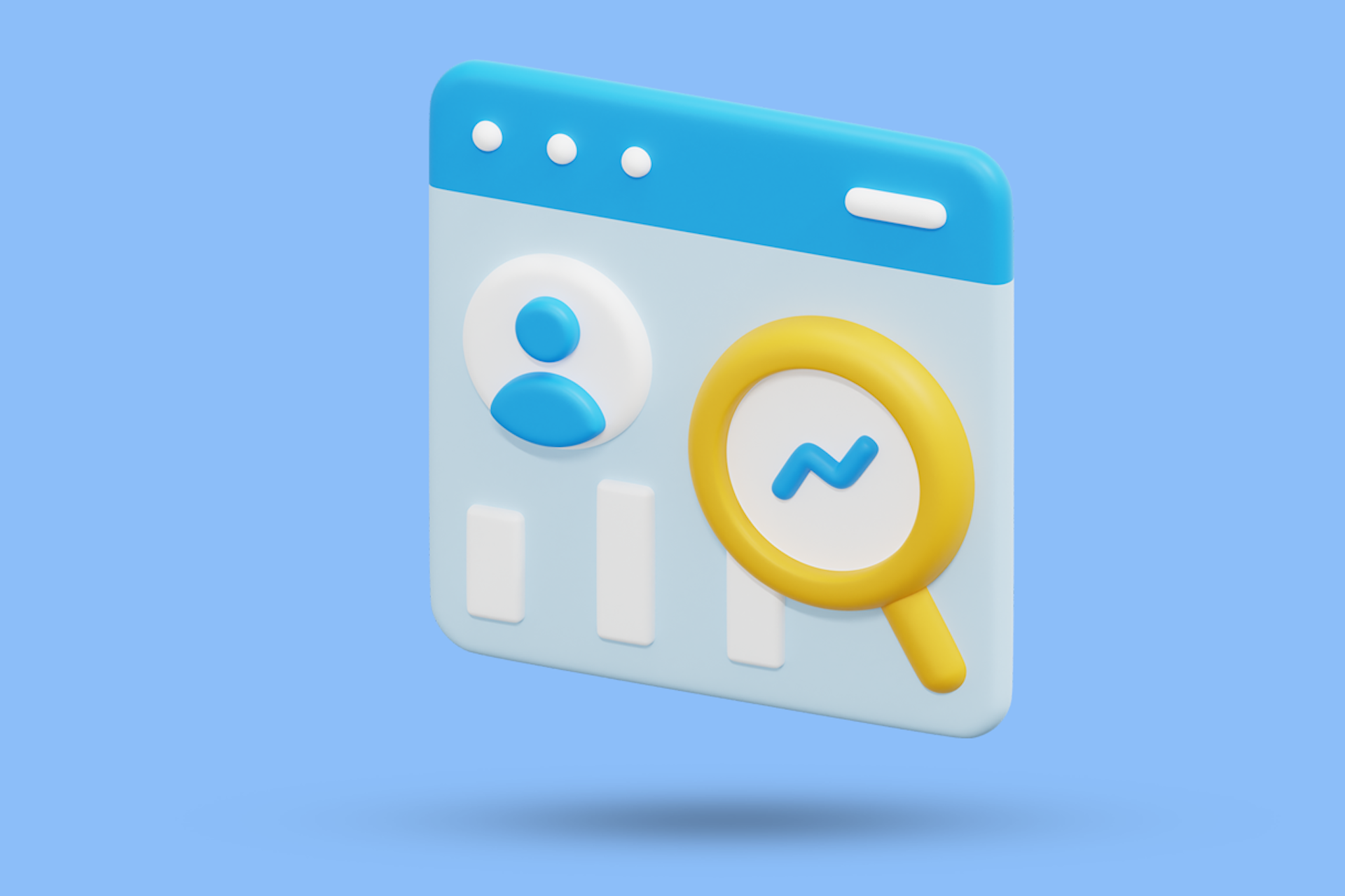
Consumer Intelligence: Definition & Examples
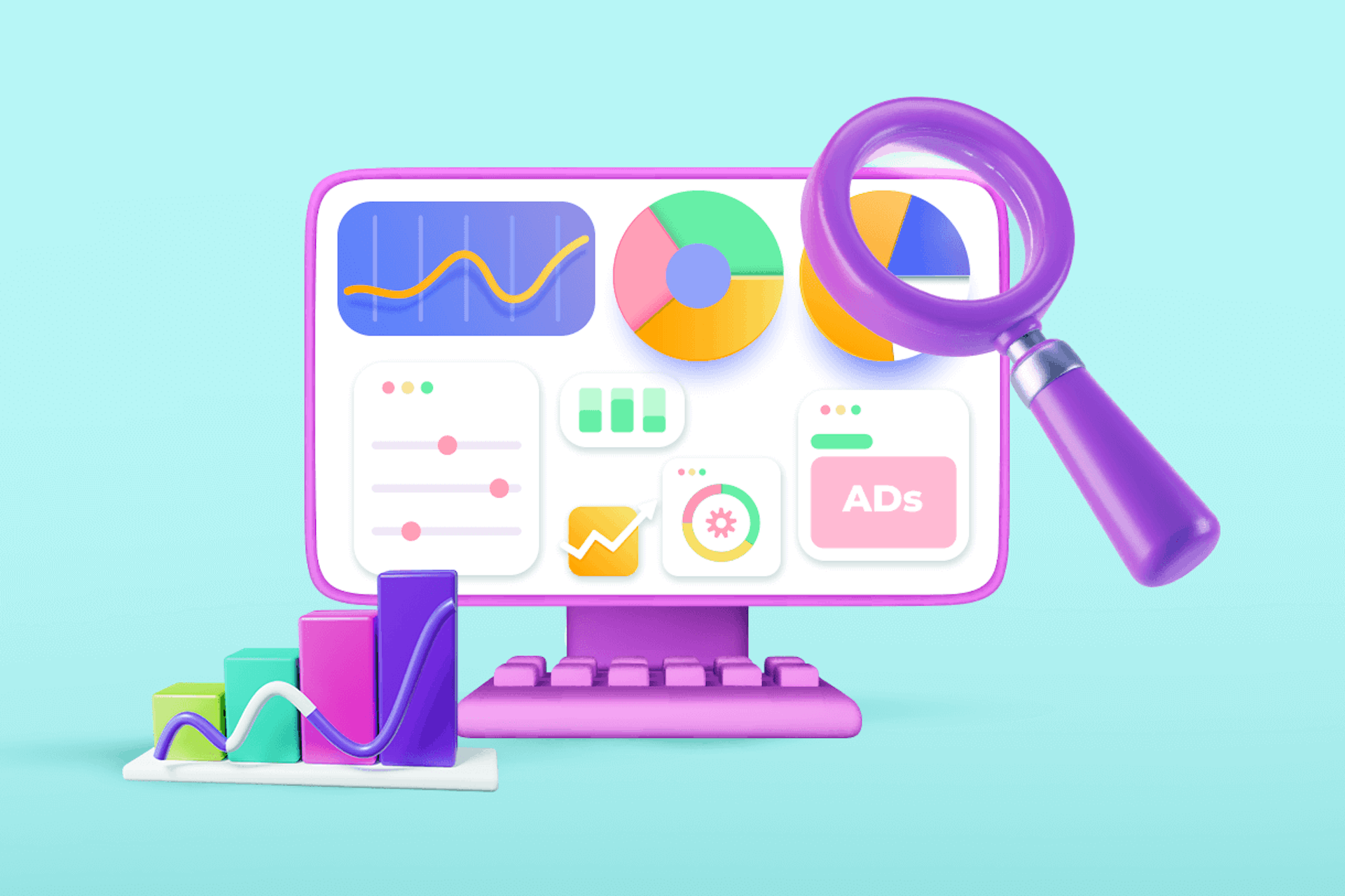
The 13 Best Market Research Tools in 2024

What is Desk Research? A Guide + Examples
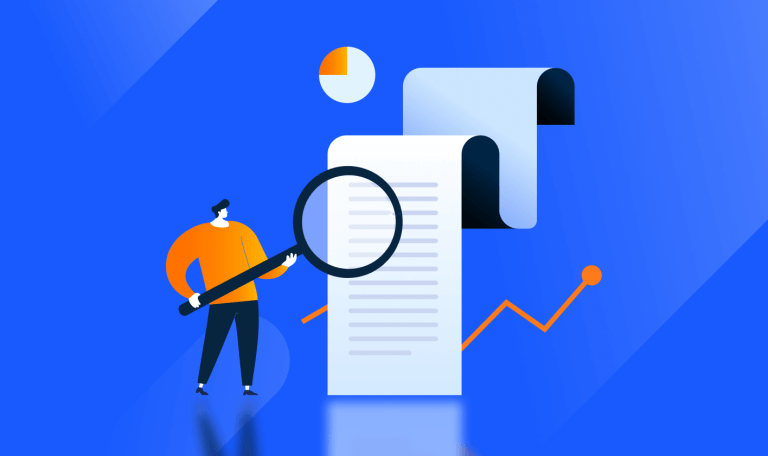
Free Website Traffic Checker
Discover your competitors' strengths and leverage them to achieve your own success
Desk research can help you make data-driven decisions, define or adapt strategies, and uncover untapped market potential to drive growth – when it’s done right!
Nowadays, we have all the information we need at our fingertips; but knowing where to find the right data quickly is key.
So, what is desk research? What does it involve, and how can Similarweb Research Intelligence help?
Let’s find out.

What is desk research?
Desk research is a type of market research that uses existing data to support or validate outcomes and conclusions. Also known as secondary research , it’s a cost-effective way to obtain relevant data from a broad range of channels.
How is desk research used?
From small start-ups to established businesses, doing desk research provides you with crucial insights into trends, competitors, and market size . Whatever you do, desk research can help with product positioning and guide data-driven business decisions that help you become the ultimate competitor and find new ways to grow.
According to the latest data on the Internet of Things , around 130 new devices connect to the web every second. Stats on the state of data show we create and consume data at an exponential rate–data interactions will only continue to rise.

Primary vs. secondary research – what’s the difference?
Most market research methods fall into either primary or secondary research. When we talk about desk research, we tend to focus only on secondary methods. However, most primary research can also be done remotely, from a desk.
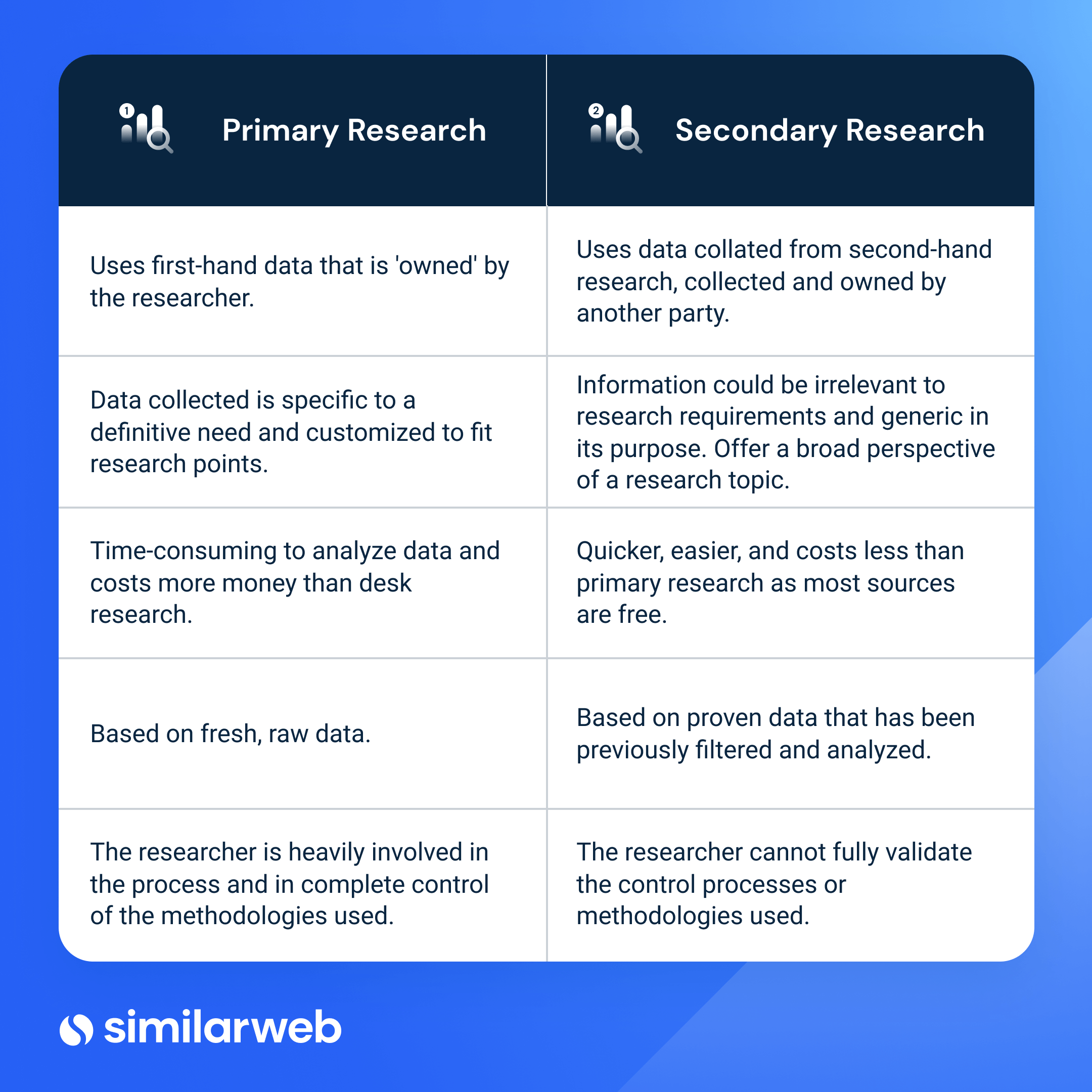
Primary research is self-conducted research that gathers data to answer questions. It usually involves going directly to a source, such as a customer or a prospect. Compared to secondary research, it takes longer, costs more, and demands more resources. Primary research methods include interviews, market research surveys , questionnaires, competitor reviews, market mapping , focus groups, etc.
Secondary research is the synthesis or summary of existing research using previously gained information from various sources. Most market research starts with secondary research: It aims to provide a researcher or analyst with a basis of knowledge formed from existing data. Secondary research methods include collecting data from the internet, government databases, reports, and academic journals, to name just a few.
Pros and cons of desk research
As with any type of market research, you need to choose the right method to deliver the best outcome for your research goal. Desk research is advantageous for several reasons, but it won’t always suit every market research project. Market research best practice tells us that we should use desk-based research before primary research – as this helps to reduce or refine the scope of the work before the second, more costly phase.
Here’s a summary of the pros and cons of desk research.
Advantages of desk-based research
Doing secondary market research is highly beneficial; here’s why.
- Low cost – most secondary research sources are low-to-no cost.
- Speed – as the data already exists, data collection is quick.
- Clarity – desk research drives & add-value to primary research actions.
- Scalability – due to the large datasets used in secondary research.
- Availability – pre-collected data is readily available to analyze.
- Insightful – get valuable insights and help resolve some initial research questions.
Disadvantages of desk-based research
As any good researcher will attest, it’s always good to look at a topic from every angle. Here are a few things to consider before starting any secondary research process.
- Out of-date data – consider if the coverage dates of the research are relevant. In a fast-moving market, having access to up-to-date information could be critical.
- Lack of perceived control over the data – secondary research is undertaken by a third party; as such, methodology controls need to be reviewed with caution.
- No exclusivity – desk research data is widely available and can be used by other researchers.
- Verification & interpretation – particularly when working with large data sets, it can take time to analyze and review to ensure the information is suitable for your research.
Types of desk-based research
Nowadays, you can do most market research from a desk. Here, I’ll focus solely on secondary research methods: Where finding and using the right resources is key. The data you use needs to be up-to-date and should always come from a trusted source.
Desk research methods – internal data resources
Before stepping into external research, look for any relevant internal sources. This data can often prove invaluable, and it’s a great place to start gathering insights that only you can see. The information is already yours, so aside from the fact it won’t cost a dime, it’s data your rivals won’t have access to.

Sources of internal information that can help you do desk research include:
- Historical campaign and sales analysis: Everything from website traffic and conversions through to sales. Accessible through your own analytics platform(s).
- Website and mobile application data: Your own platforms can also tell you where users are – such as the device split between mobile and desktop.
- Existing customer information: audience demographics , product use, and efficiency of service.
- Previous research conducted by other analysts: Even if the research seems unrelated, there could be indicative information within.
Desk research methods – external data resources
Using external data sources for desk research is an ideal way to get information about market trends, and explore a new topic.

- The internet: A virtual aggregator of all secondary research sources – always validate findings with credible sources.
- Commercial resources: Research associations and company reports usually cost money but give you data that’s specific to your industry/aim.
- Trade association reports: To see if there’s a trade association of interest, do a quick search online or use the Encyclopedia of Associations , the Directory of Associations , or the National Trade and Professional Associations Directory
- Industry Experts: Expert consultancy is an efficient way of getting information from someone who has ‘been there, done that.’ Also, consider ‘influencers.’
- Research associations & journals: Most research associations are independent and offer bespoke, specialized reports.
- Media coverage: TV, radio, newspapers, and magazines can often help uncover facts and relevant media stories related to your topic.
- Market research intelligence software: Platforms like Similarweb give you actionable insights into industry and competitors’ trends. With access to mobile app intelligence, you get a complete picture of the digital landscape.
- Government & non-government agencies: In the US, the biggest generator of data is the federal government. US Census Bureau , Congressional Research Service , US Government Publishing Office , US Small Business Administration , and the Department of Education . Most information from these sources is free.
- Local government sites: A reliable source to find data on population density or employment trends.
- Public library records: Access data via the Digital Public Library of America in the US or the National Archives in the UK.
- Competitor information: Sign-up for mailing lists, view comparison reports, and read online reviews.
- Educational institutions: Academic research papers and journals are well-researched. If you can find a relevant one, you’ll likely get solid data from credible sources.
How to choose the best type of desk research
With so many freely-available sources online for desk-based research; it’s easy to feel overwhelmed. The best guidance I can offer is to keep a list of key questions you are trying to answer with this research, and consider:
- What are you hoping to learn from your research?
- Why is this data relevant?
- Is there an action you can take from this information?
- How up-to-date is the data you are using?
Always keep the questions you’re trying to answer front of mind. It’ll help you stay focused and keep your desk research on the right track. Time and money will usually determine the right type of desk research to use, but, even then, it’s important to stay focussed on where you spend your time vs. the return on that investment.
Inspiration: This article outlines some of the best market research questions to ask.
How to do desk research in five steps
Follow these steps to guide you through doing desktop research:
1. Clearly define your research topic Identify your topic and its purpose, then list any relevant research attributes.
2. Select appropriate resources Make a list of sources that’ll provide relevant information for your research topic.
3. Look for existing data Once you’ve collated your research sources, look for internal and external data relevant to your research topic. Remember to only use data from authentic sources.
4. Collate, compare & assemble Next, you’ll need to collate all the data you’ve obtained, remove any duplication, and bring it together into a usable format.
5. Data analysis The final step of doing desk research is to analyze the data. At this point, you should be able to see if your research questions have been answered. If any questions remain unanswered, go back to step 2, and look for alternative resources that will help you get clearer insights.

Desk-based research tools
Online resources are by far your most valuable asset for doing secondary research. However, software like Similarweb Digital Intelligence , Google Analytics (GA), and Google Search Console (GSC) can save you time and give you a more visually-appealing view of relevant data.
My list of go-to tools for desk research includes:
- Google Analytics & Search Console – your own site’s performance and visitor stats.
- Similarweb Digital Research Intelligence – uncover market, industry & competitor trends across web, mobile, and apps.
- Tableau – data visualization for presenting your findings.
- Competitor data – on rival’s websites, newsletters, and social media accounts.
Read: The best market research tools of 2023
Note that GA and GSC are free to use but limited in terms of what you can see outside your own site. With Similarweb, you can access virtually limitless industry-wide data.
Stop Guessing, Start Analyzing
Get actionable insights for desk research here
How Similarweb helps with desk research
Here are just a few examples of how Similarweb Digital Research Intelligence can help you with secondary research.
- Benchmarking yourself against your industry – Benchmarking suite
- Understand how competitor websites and apps perform – Company research module
- Get a full picture of your industry – Market research & industry analysis tools
- Understand how apps are impacting your market – App Intelligence
- Analyze consumer behavior – Audience analysis tool
- Understand the complete customer journey – Consumer journey tracker
Using research intelligence tools will save you time and money while removing bias from the data – ultimately giving you clarity and a complete view of the digital world relevant to your research topic.
Success Story: See how Airbnb uses Similarweb to reveal growth opportunities in new markets .
Desk research examples with Similarweb
A good example of desk research in action is looking into an industry to uncover market leaders, trends, relevant search trends, and an overview of a complete industry. Using the market analysis module in Similarweb, you can find out exactly what’s happening in your market, and make data-driven decisions that’ll help you increase market share , and drive faster, more sustainable business growth.
For this particular desk research example, I chose the airline industry.
Let’s dive in.
Industry Overview
See a snapshot of industry traffic and engagement metrics . This data is typically based on Similarweb’s index of the top 100 websites in a chosen vertical. You can easily create a custom industry , allowing you to do competitive benchmarking against specific companies in your market.

Industry Leaders
Quickly see who is winning in an industry using the Market quadrant analysis graph and industry leaders table. Analyze top-performing websites in your vertical, and dive into their traffic and engagement performance to view bounce rates, visit duration, monthly visits, month-on-month changes, unique visitors, pages/visits, and traffic share .

Industry Trends
Analyze trends in near real-time so you can take action when it matters most–not a quarter later. Create a personalized view of your industry for in-depth analysis and make informed decisions that will help you grow your market share.

Marketing Channels
Access valuable traffic metrics and insights for each marketing channel. See data for direct, social, display ads, paid search, referrals, emails, and organic traffic channels and evaluate performance for each. Uncover opportunities to grow your own traffic share, evaluate engagement and quality of traffic, and identify trends over time.

Search Trends (within an industry)
Discover trending topics and emerging search terms in any industry. View what’s trending, search volume, % change, volume trend, and traffic leaders for both branded and non-branded search in your sector. Use these insights to get an understanding of market demand, search intent, and audience interests within a specific category, brand, or product.

Demographics
Gain crucial insights into the audiences visiting your website, your competitors’ websites, and your industry as a whole. See gender and age distribution across web, mobile, or combined traffic channels, and compare your demographics with that of your rivals.

The market analysis element of Similarweb will help you answer some of your most important research questions, such as:
- How a specific industry grew over time
- Who the top and emerging players are in your industry
- Which products or services are trending and/or what are consumers searching for
- What demographics are relevant to you, and your competitors
The app intelligence module completes the picture and gives you a broad view of the digital landscape across your market. You can quickly see how apps are impacting your industry, and look at download, engagement, installs, ranking, and more.

Here, I’m sticking with the airline industry to establish whether or not android or iOS is the best fit for a new app. Immediately, I can see there are between 1-1.5M monthly active users on iOS vs. an equivalent of around 350,000k on Android.
Like what you see? Take a tour of Similarweb for yourself.
Discover industry insights for desk research here
Wrapping up
Good desk research helps you quickly uncover key information that can shape and steer successful market research projects. When done right, you’ll be able to answer questions and discover crucial data about your industry, competitors, and key trends to consider while building a strategy for growth.
Asking the right research questions from the onset and keeping these at the forefront of your mind throughout will save time and help direct your market analysis in the right direction.
Is desk-based research free?
Depending on the method used, desktop research can be done for free. If you require industry or government agency reports, these often carry a charge but are more likely to be free from bias when compared to commercially produced reports that (sometimes) receive sponsorship.
Which businesses can utilize secondary desk research?
Desk-based research can uncover crucial insights into market trends, market sizing, and competitors. The information can be used by any size business to help guide strategic decision-making and help refine a product’s positioning.
Should you do secondary research before primary research?
Absolutely, yes. Secondary research should always come before primary or field research. The formative research phase helps pinpoint where more in-depth primary research is required. Desk research can also verify and support findings from field research but should not replace primary research–as they are each utilized under different circumstances.
Who does desk-based research?
Desk research can ‘technically’ be done by anyone, but it’s typically performed by a researcher, an analyst, or a marketing professional. Good market research has solid foundational data to drive critical business decisions. Experienced researchers and analysts are best-placed to spot opportunities, trends, and patterns when the stakes are this high.
So, while anybody can access secondary data free of charge, investing the necessary resources to do things right to get the most out of the process is essential.

by Liz March
Digital Research Specialist
Liz March has 15 years of experience in content creation. She enjoys the outdoors, F1, and reading, and is pursuing a BSc in Environmental Science.
Related Posts

Geographic Segmentation: Definition, Pros & Cons, Examples, and More

Demographic Segmentation: The Key To Transforming Your Marketing Strategy

Unlocking Consumer Behavior: What Makes Your Customers Tick?
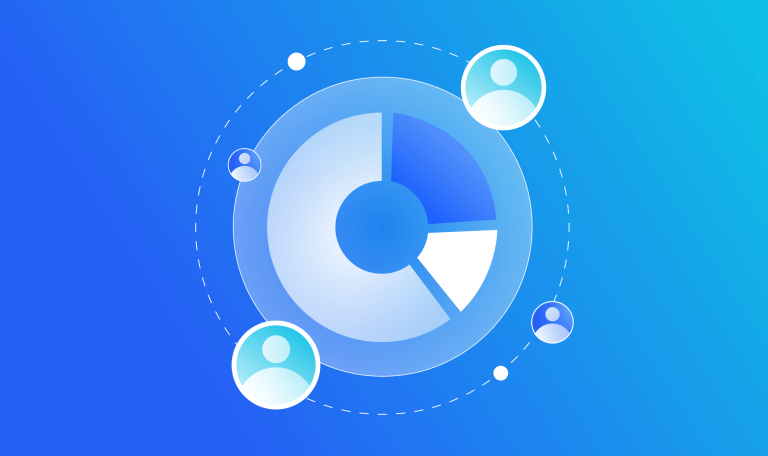
Customer Segmentation: Expert Tips on Understanding Your Audience

Market Demand 101: How to Gauge Demand for Your Products

Data Quality and Its Importance: Examples, Benefits, and Best Practices
Wondering what similarweb can do for your business.
Give it a try or talk to our insights team — don’t worry, it’s free!
- Sector público
- Sector privado
- Instituciones Educativas
- Calculadora de muestra
Desk Research: ¿Qué es y para qué sirve?

La investigación de escritorio, o desk research, se ha convertido en una herramienta esencial en el mundo de la recopilación de datos y la toma de decisiones. En una era en la que la información fluye a una velocidad vertiginosa, la capacidad de acceder y analizar datos de fuentes diversas es un recurso valioso para empresas, académicos y profesionales de diversos campos. En este artículo, exploraremos en profundidad qué es el desk research, cómo se lleva a cabo, y por qué es fundamental en el proceso de investigación. Descubre cómo esta técnica puede proporcionarte información clave para tomar decisiones más informadas y eficaces.
¿qué es el desk research .
El desk research , también conocido como investigación de escritorio o investigación documental, es una metodología de investigación que se basa en la recopilación y análisis de información existente y disponible en fuentes escritas, digitales y documentales. En lugar de realizar investigación de campo o recopilar datos de primera mano, el desk research se centra en aprovechar fuentes secundarias, como documentos, informes, estudios, artículos, bases de datos, libros y otros recursos disponibles.
Esta técnica se utiliza en una variedad de disciplinas, desde la investigación de mercado y la planificación estratégica hasta la academia y la toma de decisiones empresariales. El objetivo principal del desk research es obtener información relevante y actualizada para respaldar la toma de decisiones, la generación de conocimiento y la obtención de una comprensión más profunda de un tema o problema específico.
Ahora, adentrémonos en los aspectos clave del desk research, cómo llevarlo a cabo de manera efectiva y las ventajas que ofrece en la era de la información y la digitalización.
¿Para qué sirve el desk research?
El desk research, o investigación de escritorio, desempeña un papel fundamental en diversas áreas de la investigación y la toma de decisiones. A continuación, exploraremos las principales funciones y utilidades de esta metodología:
1.- Generación de Conocimiento: El desk research permite recopilar información existente para obtener una comprensión sólida de un tema, concepto o problema específico. Esto es útil al abordar nuevos campos de estudio o áreas desconocidas.
2.- Fundamentación Teórica: En la academia, el desk research se utiliza para respaldar teorías, argumentos y conclusiones. Permite a los investigadores encontrar evidencia empírica, citas y datos que refuercen sus planteamientos.
3.- Investigación de Mercado: En el ámbito empresarial, el desk research es una herramienta valiosa para analizar tendencias del mercado, conocer a la competencia y entender las preferencias de los consumidores. Esta información es crucial para la planificación de estrategias de marketing y desarrollo de productos.
4.- Toma de Decisiones Empresariales: Las empresas emplean el desk research para tomar decisiones informadas sobre inversiones, expansiones, fusiones y adquisiciones, entre otros aspectos. La información recopilada ayuda a minimizar riesgos y maximizar oportunidades.
5.- Planificación Estratégica: En el contexto de la planificación estratégica, el desk research proporciona datos clave para establecer metas, identificar obstáculos y definir un rumbo claro para una organización o proyecto.
6.- Políticas Públicas: Los gobiernos y las organizaciones gubernamentales utilizan el desk research para respaldar la formulación de políticas públicas. Ayuda a comprender problemas sociales, económicos y medioambientales, así como a evaluar el impacto de las políticas existentes.
7.- Investigación Científica: En la investigación científica, el desk research es fundamental para revisar la literatura existente, identificar lagunas en el conocimiento y proponer nuevas investigaciones.
8.- Ahorro de Tiempo y Recursos: Al aprovechar información disponible, el desk research puede ser una alternativa rentable y eficiente a la investigación de campo, que a menudo implica costos y recursos significativos.
En resumen, el desk research sirve como una fuente valiosa de información que respalda la toma de decisiones, el avance del conocimiento y la resolución de problemas en diversos campos. Su versatilidad y alcance lo convierten en una herramienta esencial en la era de la información.
¿Cómo realizar el desk research?
El proceso de realizar una investigación de escritorio, o desk research, implica el uso de fuentes secundarias y métodos analíticos para recopilar, analizar y sintetizar información relevante. Aprender cómo llevar a cabo una investigación de escritorio eficaz es esencial para aprovechar al máximo esta metodología y obtener datos valiosos. En esta sección, te proporcionaremos una guía paso a paso sobre cómo realizar el desk research de manera efectiva, desde la planificación inicial hasta la evaluación y presentación de los resultados.
1.- Definición del objetivo de la investigación: El primer paso es establecer claramente cuál es el propósito de tu investigación. ¿Qué información estás buscando y por qué? Define tus objetivos de investigación de manera precisa.
2.- Identificación de fuentes de información: Una vez que tengas claro tu objetivo, identifica las fuentes de información relevantes. Estas fuentes pueden incluir bases de datos en línea, bibliotecas, sitios web, documentos gubernamentales, informes de mercado, publicaciones académicas y más. Cuantas más fuentes identifiques, mejor.
3.- Recopilación de datos: Accede a las fuentes identificadas y comienza a recopilar datos. Esto puede involucrar la búsqueda de documentos, informes, estadísticas, artículos, y cualquier otro recurso que contenga información relacionada con tu objetivo de investigación.
4.- Evaluación de la calidad de la información: No todas las fuentes son igualmente confiables. Es fundamental evaluar la calidad y credibilidad de la información recopilada. Considera la fuente, la fecha de publicación, la metodología utilizada y si la información proviene de una entidad confiable.
5.- Análisis de datos: Una vez que hayas recopilado los datos, realiza un análisis crítico. Examina las tendencias, patrones, relaciones y cualquier otro aspecto relevante. Organiza los datos de manera lógica para facilitar su interpretación.
6.- Presentación de resultados: La forma en que presentas tus hallazgos es crucial. Utiliza gráficos, tablas, informes escritos u otras herramientas visuales para comunicar tus resultados de manera efectiva.
7.- Conclusiones y recomendaciones: Con base en tu análisis, elabora conclusiones sólidas y recomendaciones. ¿Qué implicaciones tienen tus hallazgos? ¿Qué acciones se deben tomar en función de la investigación?
8.- Revisión y actualización: El desk research es un proceso continuo. Asegúrate de mantener tus fuentes actualizadas y revisar periódicamente la información. La investigación de escritorio evoluciona con el tiempo, por lo que es importante mantenerse al día.
El desk research es un proceso continuo. Asegúrate de mantener tus fuentes actualizadas y revisar periódicamente la información. La investigación de escritorio evoluciona con el tiempo, por lo que es importante mantenerse al día. Si te encuentras en busca de apoyo profesional para llevar a cabo un desk research efectivo, en Berumen , una agencia de investigación de mercados con amplia experiencia, estamos aquí para asesorarte y brindarte el respaldo necesario. ¡Contáctanos para obtener más información!
Conclusión
El desk research es una herramienta poderosa para obtener información valiosa sin necesidad de llevar a cabo costosos estudios de campo. A través de la recopilación y análisis de datos y fuentes existentes, las organizaciones pueden tomar decisiones informadas, identificar tendencias y oportunidades, y mantenerse al tanto de su entorno competitivo. Al seguir los pasos adecuados y las mejores prácticas, es posible realizar una investigación de escritorio efectiva y aprovechar al máximo los recursos disponibles.
En un mundo donde la información es esencial, el desk research se ha convertido en un aliado fundamental para empresas, investigadores y profesionales de diferentes campos. Aprovechar al máximo esta metodología implica mantenerse actualizado, utilizar fuentes confiables y ser diligente en la recopilación y análisis de datos. Si deseas explorar aún más las posibilidades del desk research o necesitas apoyo en tu próximo proyecto, no dudes en consultar a expertos en investigación de mercados como Berumen. Estaremos encantados de apoyarte en tus proyectos.

Errores en la Investigación de Mercados que debes conocer
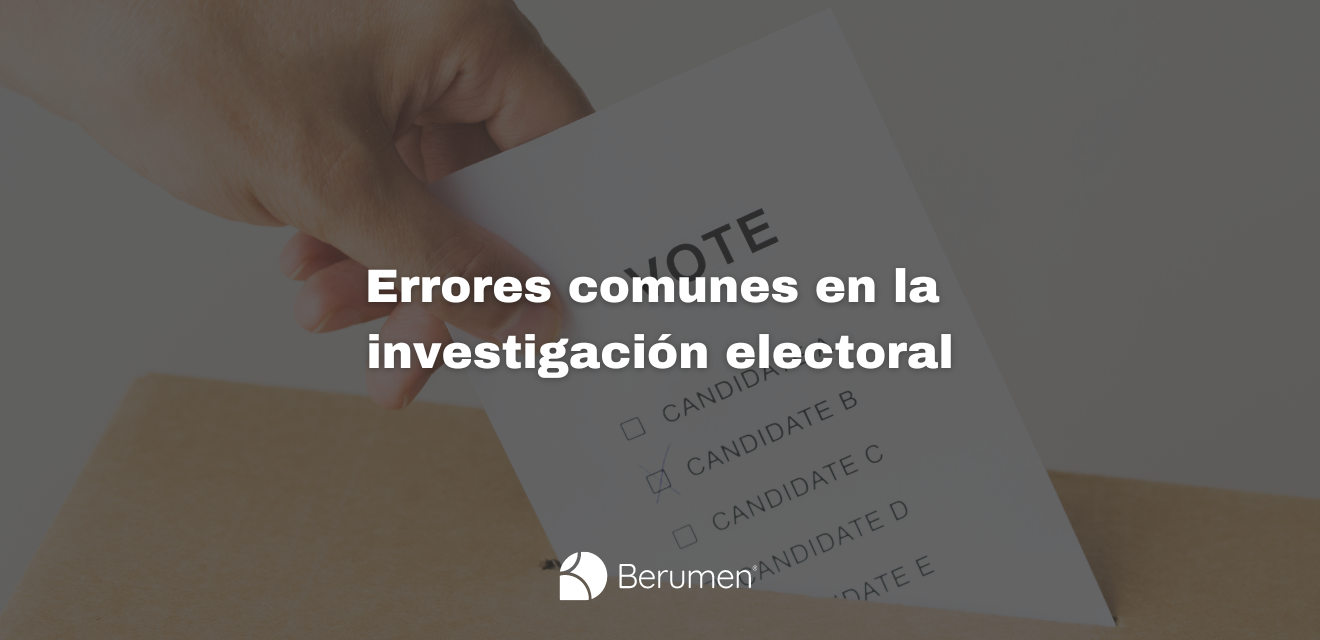
Optimizando la Investigación Electoral: Evita Estos Errores Comunes
¿Necesitas asistencia? Escríbenos o llámanos.
- Ciudad de México: (55) 5093-8600
- Monterrey: (81) 8356-1820
- Guadalajara: (33) 3616-1334
Ingresa tus datos y uno de nuestros asesores te contactará en breve.
- Skip to main content
- Skip to primary sidebar
- Skip to footer
- QuestionPro

- Solutions Industries Gaming Automotive Sports and events Education Government Travel & Hospitality Financial Services Healthcare Cannabis Technology Use Case AskWhy Communities Audience Contactless surveys Mobile LivePolls Member Experience GDPR Positive People Science 360 Feedback Surveys
- Resources Blog eBooks Survey Templates Case Studies Training Help center
Home Market Research
Desk Research: What it is, Tips & Examples

What is desk research?
Desk research is a type of research that is based on the material published in reports and similar documents that are available in public libraries, websites, data obtained from surveys already carried out, etc. Some organizations also store data that can be used for research purposes.
It is a research method that involves the use of existing data. These are collected and summarized to increase the overall effectiveness of the investigation.
Secondary research is much more cost-effective than primary research , as it uses existing data, unlike primary research, in which data is collected first-hand by organizations, companies, or may employ a third party to obtain the data in your name.
LEARN ABOUT: Data Management Framework
Desk research examples
Being a cost-effective method, desk research is a popular choice for businesses and organizations as not everyone can pay large sums of money to conduct research and collect data. That is why it’s also called “ documentary research “.
Here are some more common secondary research methods and examples:
1. Data available on the Internet: One of the most popular ways to collect data for desk research is through the Internet. The information is available and can be downloaded with just one click.
This data is practically free or you may have to pay a negligible amount for it. Websites have a lot of information that companies or organizations can use to meet their research needs. However, you need to consider a reliable website to collect information.
2. Government and non-government agencies: Data for secondary research can also be collected from some government and non-government agencies. There will always be valuable and relevant data that companies or organizations can use.
3. Public libraries: Public libraries are another good source to search for data by doing desk research. They have copies of important research that has been done before. They are a store of documents from which relevant information can be extracted.
The services offered at these public libraries vary. Most often, they have a huge collection of government publications with market statistics, a large collection of business directories, and newsletters.
4. Educational Institutions: The importance of collecting data from educational institutions for secondary research is often overlooked. However, more research is done in colleges and universities than in any other business sector.
The data collected by universities is mainly used for primary research. However, companies or organizations can go to educational institutions and request data.
5. Sources of business information: Newspapers, magazines, radio and television stations are a great source of data for desk research. These sources have first-hand information on economic developments, the political agenda, the market, demographic segmentation and similar topics.
Companies or organizations can request to obtain the most relevant data for their study. Not only do they have the opportunity to identify your potential customers, but they can also learn the ways to promote their products or services through these sources, as they have a broader scope.
Differences between primary research and Desk Research
| Primary research | Secondary research |
|---|---|
| Research is carried out first-hand to obtain data. The researcher “owns” the collected data. | The research is based on data collected from previous research. |
| Primary research is based on raw data. | Secondary research is based on proven data that is previously analyzed and filtered. |
| The data collected is adjusted to the needs of a researcher, it is personalized. Data is collected based on the absolute needs of organizations or companies. | The data may or may not be in accordance with the requirement of a researcher. |
| The researcher is deeply involved in data collection. | Unlike primary research, secondary research is quick and easy. Its aim is to achieve a broader understanding of the subject. |
| Primary research is an expensive and time-consuming process to collect and analyze the data. | Secondary research is a quick process, as the data is available. The researcher must know where to explore to obtain the most appropriate data. |
How to do a desk research
These are the steps to follow to conduct a desk investigation:
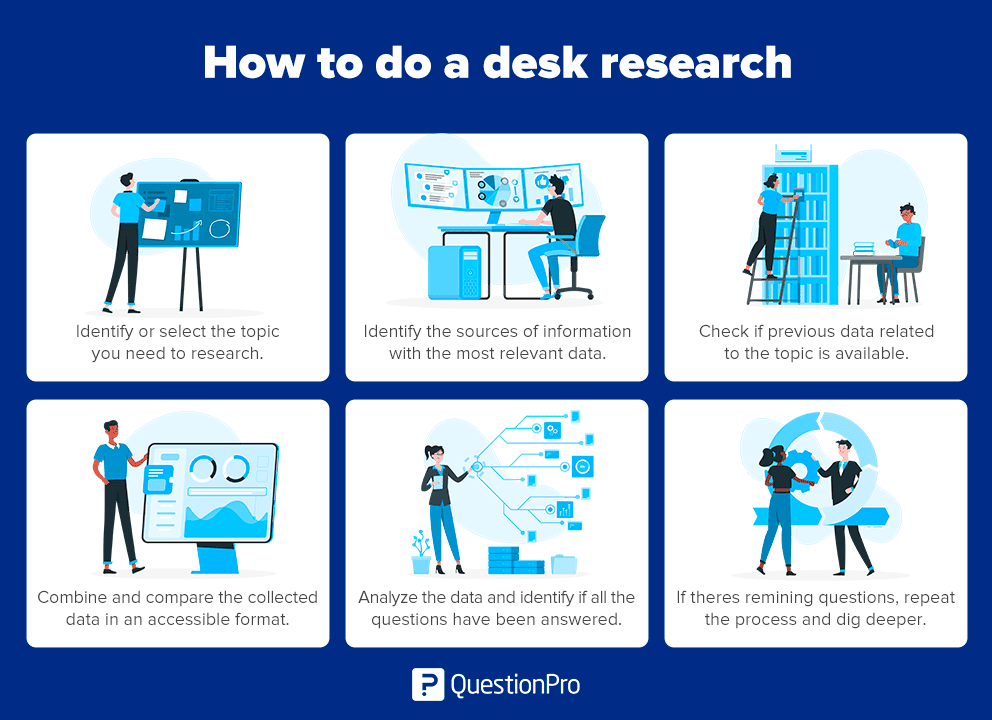
- Identify the research topic: Before you begin, identify the topic you need to research. Once done, make a list of the attributes of the research and its purpose.
- Identify research sources: Subsequently, explain the sources of information that will provide you with the most relevant data applicable to your research.
- Collect existing data: Once the sources of information collection have been narrowed, check to see if previous data is available that is closely related to the topic. They can be obtained from various sources, such as newspapers, public libraries, government and non-government agencies, etc.
- Combine and compare: Once the data is collected, combine and compare it so that the information is not duplicated and put it together in an accessible format. Make sure to collect data from authentic sources so you don’t get in the way of your investigation.
- Analyze data: Analyze the data that is collected and identify if all the questions have been answered. If not, repeat the process to dig deeper into practical ideas.
- Most of the information is secondary research and readily available. There are many sources from which the data you need can be collected and used, as opposed to primary research, where data must be collected from scratch.
- It is a less expensive and time-consuming process, as the required data is readily available and does not cost much if it is extracted from authentic sources.
- The data that is collected through secondary or desktop research gives organizations or companies an idea about the effectiveness of primary research. Thus, a hypothesis can be formed and the cost of conducting the primary research can be evaluated.
- Doing desk research is faster due to the availability of data. It can be completed in a few weeks, depending on the objective of the companies or the scale of the data required.
Disadvantages
- Although the data is readily available, the credibility and authenticity of the available information must be assessed.
- Not all secondary data resources offer the latest reports and statistics. Even when they are accurate, they may not be up to date.
Desk research is a very popular research method, because it uses existing and reliable data that can be easily obtained. This is a great benefit for businesses and organizations as it increases the effectiveness of the investigation.
QuestionPro provides the best market research platform to uncover complex insights that can propel your business to the forefront of your industry.
START A FREE TRIAL
MORE LIKE THIS

Age Gating: Effective Strategies for Online Content Control
Aug 23, 2024

Customer Experience Lessons from 13,000 Feet — Tuesday CX Thoughts
Aug 20, 2024

Insight: Definition & meaning, types and examples
Aug 19, 2024

Employee Loyalty: Strategies for Long-Term Business Success
Other categories.
- Academic Research
- Artificial Intelligence
- Assessments
- Brand Awareness
- Case Studies
- Communities
- Consumer Insights
- Customer effort score
- Customer Engagement
- Customer Experience
- Customer Loyalty
- Customer Research
- Customer Satisfaction
- Employee Benefits
- Employee Engagement
- Employee Retention
- Friday Five
- General Data Protection Regulation
- Insights Hub
- Life@QuestionPro
- Market Research
- Mobile diaries
- Mobile Surveys
- New Features
- Online Communities
- Question Types
- Questionnaire
- QuestionPro Products
- Release Notes
- Research Tools and Apps
- Revenue at Risk
- Survey Templates
- Training Tips
- Tuesday CX Thoughts (TCXT)
- Uncategorized
- What’s Coming Up
- Workforce Intelligence
Copyright © SurveySparrow Inc. 2024 Privacy Policy Terms of Service SurveySparrow Inc.
Desk Research 101: Definition, Methods, and Examples

Parvathi Vijayamohan
Last Updated: 13 August 2024
12 min read

Table Of Contents
- Desk Research Guide
- What is Desk Research
- Desk Research Methods
- Desk Research Benefits
- Desk Research Drawbacks
- When to Use Desk Research - Examples
- How to Do Research
If you ever had to do a research study or a survey at some point, you would have started with desk research .
There’s another, more technical name for it – secondary research. To rewind a bit, there are two types of research: primary , where you go out and study things first-hand, and secondary , where you explore what others have done.
But what is desk research? How do you do it, and use it? This article will help you:
- What is desk research
- Different desk research methods
- Desk research benefits
- Major drawbacks of desk research
- Desk research examples
- How to do desk research
What is Desk Research?
Desk research can be defined as a type of market/product research, where you collect data at your desk (metaphorically speaking) from existing sources to get initial ideas about your research topic.
Desk research or secondary research is an essential process from a business’s point of view. After all, secondary data sources are such an easy way to get information about their industry, trends, competitors, and customers.
Types of Secondary Data Sources
#1. Internal secondary data: This consists of data from within the researcher’s company. Examples include:
- Company reports and presentations
- Case studies
- Podcasts, vlogs, and blogs
- Press releases
- Websites and social media
- Company databases and data sets
#2. External secondary data: Researchers collect this from outside their respective firms. Examples include:
- Digital and print publications
- Domain-specific publications and periodicals
- Online research communities, like ResearchGate
- Industry speeches and conference presentations
- Research papers
Difference Between Desk Research and Primary Research
Research is mainly two parts - primary and secondary (desk). Here’s a brief take on the difference between the two. This will help you clear up any doubts you have.
| Desk Research | Primary Research |
|---|---|
| Research is done on the existing data. | Research is done on original, first-hand data. |
| Uses data from secondary sources like books, reports, databases, etc. | Gathers data directly from original sources through surveys, interviews, etc. |
| Relies heavily on analyzed and interpreted information. | Collects raw, unanalyzed data. |
| Data may not be specific to researchers' needs. | Data can be tailored to each research objective. |
| Relatively inexpensive as the data is already collected and analyzed. | Comparatively expensive as data collection is done from scratch. |
| Some examples are literature reviews, industry reports, market statistics, etc. | Some examples are surveys, interviews, focus groups, etc. |
6 Popular Desk Research Methods
If you are seeking ways to conduct desk research, here are some methods you can follow.

The Internet
No surprise there. When was the last time you checked a book to answer the burning question of “Is pineapple on pizza illegal?” (it should be).
However, choosing authentic and credible sources from an information overload can be tricky. To help you out, the Lydia M. Olson Library has a 6-point checklist to filter out low-quality sources. You can read them in detail here .
You have earned some serious street cred if your preferred source is a library. But, jokes apart, finding the correct information for your research topic in a library can be time-consuming.
However, depending on which library you visit, you will find a wealth of verifiable, quotable information in the form of newspapers, magazines, research journals, books, documents, and more.
Governmental and Non-Governmental Organizations
NGOs, and governmental agencies like the US Census Bureau, have valuable demographic data that businesses can use during desk research. This data is collected using survey tools like SurveySparrow .
You may have to pay a certain fee to download or access the information from these agencies. However, the data obtained will be reliable and trustworthy.
Educational Institutions
Colleges and universities conduct plenty of primary research studies every year. This makes them a treasure trove for desk researchers.
However, getting access to this data requires legwork. The procedures vary according to the institution; among other things, you will need to submit an application to the relevant authority and abide by a data use agreement.
Company Databases
For businesses, customer and employee data are focus areas all on their own. But after the pandemic, companies are using even more applications and tools for the operations and service sides.
This gives businesses access to vast amounts of information useful for desk research and beyond. For example, one interesting use case is making employee onboarding more effective with just basic employee data, like their hobbies or skills.
Commercial Information Media
These include radio, newspapers, podcasts, YouTube, and TV stations. They are decent sources of first-hand info on political and economic developments, market research, public opinion, and other trending subjects.
However, this is also a source that blurs the lines between advertising, information and entertainment. So as far as credibility is concerned, you are better off supporting this data with additional sources.
Collect Up-to-date Data
How Can Desk Research Be Helpful?
The following listed are some ways desk research can really help you.
#1. Better Domain Understanding
Before doing market research, running a usability test, or starting any user-centric project, you want to see what companies have done in the past (in related areas, if not the same domain). Then, instead of learning everything from scratch, you can review their research, successes, and mistakes and learn from them.
#2. Quicker Opportunity Spotting
How do you know if you’ve found something new? By reviewing what has gone before. By doing this, you can spot gaps in the data that match up with the problem you’re trying to solve.
#3. More Money Saved
Thanks to the internet, most of the data you need is at your fingertips, and they are cheaper to compile than field data. With a few (search and mental) filters, you can quickly find credible sources with factual information.
#4. More time saved
You have less than 15 minutes with your research participant. Two minutes if you’re doing an online survey. Do you really want to waste that time asking questions that have already been answered elsewhere? Lack of preparation can also hurt your credibility.
#5. Better Context
Desk research helps to provide focus and a framework for primary research. By using desk research, companies can also get the insight to make better decisions about their customers and employees.
#6. More Meaningful Data
Desk research is the yin to the yang of field research – they are both required for a meaningful study. That’s why desk research serves as a starting point for every kind of study.
This brings us to the last question.
5 Major Drawbacks of Desk Research
While there are some benefits when doing desk research, it comes with its drawbacks and challenges. Let's have a look at them.

Data Relevancy and Accuracy
To make informed decisions, it's crucial to have up-to-date data. With most of the data in desk research already collected, the probability of it being relevant to contemporary use is low. With inaccurate data, the end results can be skewed.
Depth and Insight Provided
It's possible that the insight of the data in desk research can't be as deep, especially in qualitative aspects. For example, for something like understanding consumer behavior or preferences, you need new and fresh data. This is not possible with desk research.
If you are someone looking to learn more about your customer, then we recommend going for primary research… preferably using tools like SurveySparrow .
The tool can help you collect fresh and up-to-date data and understand your customers better. From their preferences to emotions, learn about your customers comprehensively.
14-day free trial • Cancel Anytime • No Credit Card Required • No Strings Attached
Data Bias and Inconsistency
Data obtained from existing sources can be biased or incomplete. Each researcher has a different perspective (or agenda), and depending on that, the researched data can be focused. Therefore, it's safe to say that you can expect the data to be incompatible.
Data Accessibility
The data availability or accessibility can be a major issue. Though you can find research materials existing, it's not necessary that you will be able to access them.
For example, consider Statista. It's one of the top companies that provide industry and region-focused statistics reports. However, except for a few, most of the data are available only on purchase, which, by the way, is expensive...very expensive.
Time Consumption
Tracking down all the necessary researched data for your desk research can be quite a time-consuming process. Not to mention how monotonous it can be.
Use Cases Where You Can Use Desk Research - Examples
The following are some use cases where desk research has been used. Go through them and learn how and when to use desk research.
#1. Testing Product-Audience Match
Let’s say you’re developing a fintech product. You want to do a concept testing study. To make sure you get it right, you’re interested in finding out your target audience’s attitudes about a topic in your domain. For e.g., Gen Z’s perceptions about money in the US.
With a quick Google search, you get news articles, reports, and research studies about Gen Z’s financial habits and attitudes. Also, infographics and videos provide plenty of quantitative data to draw on.
These steps are a solid starting point for framing your concept testing study. You can further reduce the time spent on survey design with a Concept Testing Survey Template . Sign up to get free access to this and hundreds more templates.

#2. Tracking the Evolution of the Web
As we wade into the brave new world of Web 5.0 , there are quite a few of us who still remember static websites, flash animations, and images sliced up into tables.
If you want to refresh your memory, you can hop on the Wayback Machine . iI gives you access to over 20 years of web history, with over 635 billion web pages saved over time!
Curiosity aside, there are practical use cases for this web archive. SEO specialist Artur Bowsza explores this in his fantastic article Internet Archeology with the Wayback Machine .
Imagine you’re investigating a recent drop in a website’s visibility. You know there were some recent changes in the website’s code, but couldn’t get any details. Or maybe you’re preparing a case study of your recent successful project, but the website has changed so much, and you never bothered to take a screenshot. Wouldn’t it be great to travel back in time and uncover the long-forgotten versions of the website – like an archaeologist, discovering secrets from the past but working in the digital world?
#3. Repairing a Business Reputation
As a brand, you hope that a crisis never happens. But if hell does break loose, having a crisis management strategy is essential.
If you want examples, just do a Google search. From Gamestop getting caught in a Reddit stock trading frenzy to Facebook being voted The Worst Company of 2021 , we have seen plenty of brands come under fire in recent years.
Some in-depth desk research can help you nail your crisis communication. Reputation management expert Lida Citroen outlines this in her article 7 Ways to Recover After a Reputation Crisis .
Conduct a thoughtful and thorough perception sweep of the reputation hit’s after-effects. This includes assessing digital impact such as social media, online relationships and Google search results. The evaluation gives you a baseline. How serious is the situation? Sometimes the way we believe the situation to be is not reflected in the business impact of the damage.
How Do You Do Desk Research?
Good question! In her blog post , Lorène Fauvelle covers the desk research process in detail.
You can also follow our 4-step guide below.
- First, start with a general topic l ike “handmade organic soaps”. Read through existing literature about handmade soaps to see if there is a gap in the literature that your study can fill.
- Once you find that gap, it’s time to specify your research topic . So in the example above, you can specify it like this: “What is the global market size for handmade organic soaps”?
- Identify the relevant secondary data for desk research. This only applies if there is past data that could be useful for your research.
- The aim of the previous study
- The author/sponsors of the study
- The methodology of the study
- The time of the research
Note: One more thing about desk research…
Beware of dismissing research just because it was done a few years ago. People new to research often make the mistake of viewing research reports like so many yogurts in a fridge where the sell-by dates have expired. Just because it was done a couple of years ago, don’t think it’s no longer relevant. The best research tends to focus on human behaviour, and that tends to change very slowly. Dr David Travis, Desk Research: The What, Why and How
That’s all folks! We hope this blog was helpful for you.
How have you used desk research for your work? Let us know in the comments below.

Content marketer at SurveySparrow.
Parvathi is a sociologist turned marketer. After 6 years as a copywriter, she pivoted to B2B, diving into growth marketing for SaaS. Now she uses content and conversion optimization to fuel growth - focusing on CX, reputation management and feedback methodology for businesses.
You Might Also Like


Double-Barreled Questions: Definition, Examples, and How to Avoid Them

6 Major Mistakes to Avoid When Managing a Work From Home Team

What Is Cryptocurrency? 5 Best Cryptocurrencies to Invest in 2024 & More!

Customer Experience
The Feedback Funnel in Customer Service: A Comprehensive Guide
Turn every feedback into a growth opportunity.
14-day free trial • Cancel Anytime • No Credit Card Required • Need a Demo?

El verano ya está aquí, y las rebajas también. ¡Consigue hoy un plan anual con hasta un 65% de descuento! 🌴🌞
- Generador De Formularios
- Creador de Encuestas
- Creador de Cuestionarios
- Generador de Formularios AI
- Herramienta de encuesta AI
- Creador de Cuestionarios AI
- Formulario de pedido
- Complemento de WordPress
HubSpot CRM
Google Sheets
Google Analytics
Microsoft Excel
- Formularios Populares
- Plantilla de Formulario de Solicitud de Empleo
- Plantilla de Formulario de Solicitud de Alquiler
- Plantilla de Formulario de Alojamiento de Hotel
- Plantilla de Formulario de Registro
- Formularios
- Formularios de Solicitud
- Formularios de Reserva Previa
- Formularios de Consentimiento
- Formularios de Contacto
- Formularios de Donación
- Encuestas de Satisfacción del Cliente
- Encuestas de Satisfacción de los Empleados
- Encuestas de Evaluación
- Encuestas de retroalimentación
- Encuestas de Investigación de Mercado
- Formularios de Cuestionarios
- Plantilla de Cuestionario de Personalidad
- Plantilla de Cuestionario de Geografía
- Plantilla de Cuestionario de Matemáticas
- Plantilla de Cuestionario de Ciencias
- Plantilla de Cuestionario de Vocabulario
Prueba sin registrarte Inicio Rápido
Lea historias atractivas, guías prácticas, aprenda sobre las características de las forms.app.
Plantillas inspiradoras listas para usar para comenzar de manera rápida y eficaz.
Guías precisas sobre cómo usar forms.app y sacarle el máximo provecho.
Vea las medidas técnicas que tomamos y aprenda cómo mantenemos sus datos seguros y protegidos.
- Página principal
- Caracteristicas
- Integraciones
- Centro de Ayuda
- Iniciar Sesión Regístrate Gratis
What is desk research: Definition, tips & examples
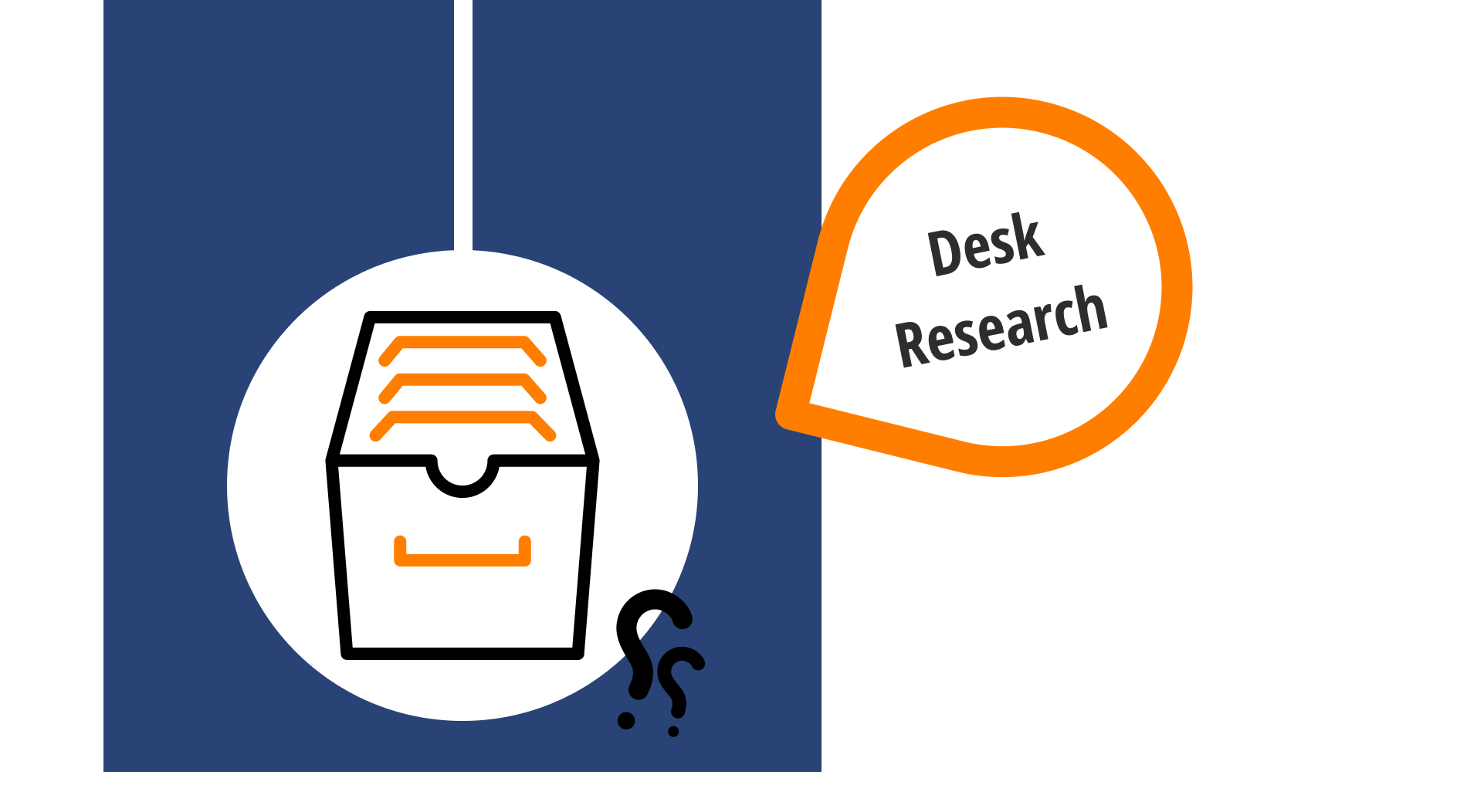
Defne Çobanoğlu
Every research starts with thinking and then continues with reading. Lots of reading 🤓. It’s because you have to know what other scientists, marketers, and researchers have found on the subject so you can build on it. This is basically what desk research is.
In this article, you will learn what secondary or desk research is and how to do it with some excellent tips and examples. Let us get started with the basic definition!
- What is desk research?
In layman’s terms, desk research is a type of research where you gather data while “ sitting at a desk .” It is another name for secondary research where the study itself is desk-based research and not experiment-based research.
Broadly speaking, there are two types of main research types. One of them is primary research , where the researcher tries to gather data firsthand (directly from the data source). The other one is secondary research , where the researcher is going through secondary data from published books, case studies, and other quantitative research. In other words, secondary research basically equals desk research.
- Why do you need desk research?
No matter the objective of the study, desk research should always be the first step. Because previously done experimental research and explanatory research give a good starting point. If you can take advantage of the existing information, it is always constructive to see what was previously said. But that is not the only reason to use this research method. So here are the advantages of desk research:
✅Insightfulness
It would be foolish of you to just jump into the middle of research without doing any research beforehand. A researcher who collects data before going along with their plan will gather substantial information and continue with their plan with this obtained insightfulness.
✅Time efficiency
Conducting a full-on study from start to finish is quite time-consuming. However, secondary data is right there waiting to be inspected. Thanks to that, the data collection is very quick.
✅Availability
As mentioned above, the secondary data collection sources are available on many platforms. They can be found in libraries, databases, online sources, booklets, and many more.
✅Cost-effectiveness
In addition to the other advantages, doing desk research is very cheap, too. So long as you can access a library or have an internet connection, you can gather the appropriate data without a cost.

The benefits of desk research
- How to do desk research
The best approach to any research is a systematic one. That is why you should always have a plan or outline you will follow during your research. And we have gathered this step-by-step plan to guide you on your desk research. You can use it as is or build on these steps.
- Identify the topic: The first thing is to identify the research topic clearly to make sure you know what you want to know.. (You can change the topic as you explore the concept further.)
- Find research sources: Secondly, go on and identify the research sources.
- Collect data: Afterward, you can start collecting data from these sources. Go through every option to gather as much information as possible.
- Combine everything: Combine all that you gathered and compare it with the other information you collected. Make sure there are no contradictions.
- Make an informed analysis: The last step is to try to see if the findings answer the research topic well enough or not. If not, you can change the question or repeat the process. If you are satisfied with the findings you can decide if you want to continue with exploratory research methods to further your findings.
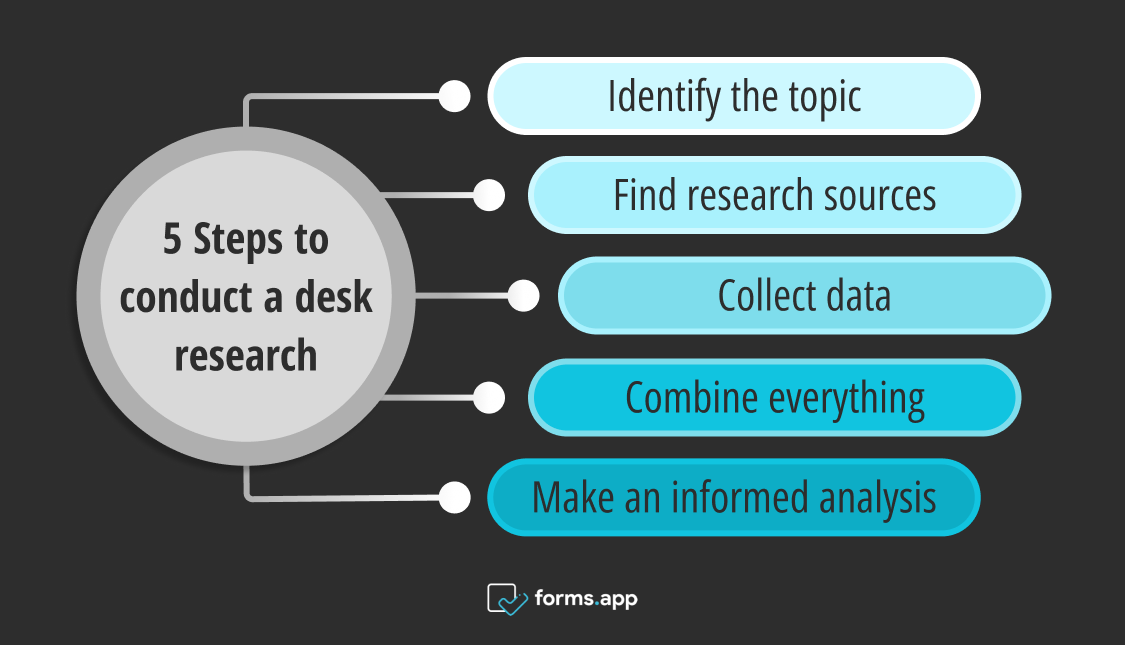
5 Steps to conduct a desk research
- Expert tips for desk research
Even the simplest task is best done by following a structured plan and organization. In addition to this, if you are planning to start your desk research, you should mind these smart tips to guide you in your way:
- Make sure the data you collect is not outdated .
- Take systematic notes while going through the sources so as not to get mixed up.
- Be critical and analytical and question your findings to make sure there are no contradictions.
- Do not limit yourself to just a few sources. It is better to make use of all options .
- Do not be biased. Stay open-minded . If you limit yourself to only a number of sources, your findings will be more than likely, insufficient. You should broaden your perspective by looking into various sides and frames.
- You can change course according to your findings. Do not feel limited to a frame.
- You can combine and support your findings with some primary research techniques such as surveys, interviews, or observations.
- Applications of desk research
Now, we know how to do desk research, what to have in mind, and its advantages. But on what occasions can you use this type of research? Let us see some examples of desk research.
1. Doing market research on a subject
When you want information on the latest fashion trends and clothing preferences of teenagers, it is best to consult appropriate data. You can read through magazines, fashion articles, fashion brand reports, and so on. Worth the data you obtain, you can build your fashion brand or create an eye-catching ad.
2. When you have an academic approach
Let us say you are a scholar who specializes in second language acquisition in children in a bilingual household. You can check out available online academic sources such as Google Scholar, ResearchGate, Wiley Online Library, or Library Genesis. There, you can find previously done studies, articles, and statistics.
3. Getting a general idea of a specific group of people
Let us say you will work with or around university students aged 18-28, and you want to know more about their behaviors and preferences to make informed decisions. You can use sources such as textbooks, news articles, reviews, journal entries, and previously done interviews and surveys.
- Frequently asked questions about desk research
What are the common resources for desk research?
The sources for desk research are limitless. Because they are basically every study conducted on the research topic. As long as they are organized, tangible, and objective , there is no problem using them. Some appropriate resources for desk research are:
- Published books
- Case studies
- Directories
- Company financial data
- Government statistics
- Commercial publications
When is desk research not reliable?
You may go through the relevant sources all you want, but if you fail to make sure the data is accurate, this can disrupt your project. There are some instances where desk research is not reliable and usable. For example, you can not use information that is outdated, biased, insufficient, irrelevant, or inaccurate .
Desk research vs. Empirical research
Empirical research is based on observation as directly experienced by the researcher. And even though secondary research backs up the theory part, empirical data is a primary research method . In desk research, the researcher goes through existing sources; therefore, desk research is a secondary research method.
Desk research vs. Primary research
Desk research is also known as secondary research and it involves collecting data from secondary sources such as published documents. And, primary research involves collecting data directly from the original sources. For example, doing experiments, observations, or interviews.
Desk research vs. Field research
Desk research, also known as secondary research, is when data collection is completed from secondary sources such as published documents or website sources. Field research, also known as primary research, is when data collection is directly from the source about a specific subject.
In desk research you collect pre-existing information while in field research you create new knowledge via exploration.
Desk research is an essential part of any study, no matter the concept. Thanks to desk research, the researcher collects all available data to draw their own conclusions or support their research theory.
It can be done using a number of source materials from books, reports, analyses, and entries. İt is a valuable part of the study. Desk research has its own advantages, and it can be perfected with some tips as well. What's more, you can use a smart tool such as a form and survey maker tool like forms.app to help you with all your research subjects!
Defne is a content writer at forms.app. She is also a translator specializing in literary translation. Defne loves reading, writing, and translating professionally and as a hobby. Her expertise lies in survey research, research methodologies, content writing, and translation.
- Form Features
- Data Collection
Índice de Contenidos
Entradas relacionadas.
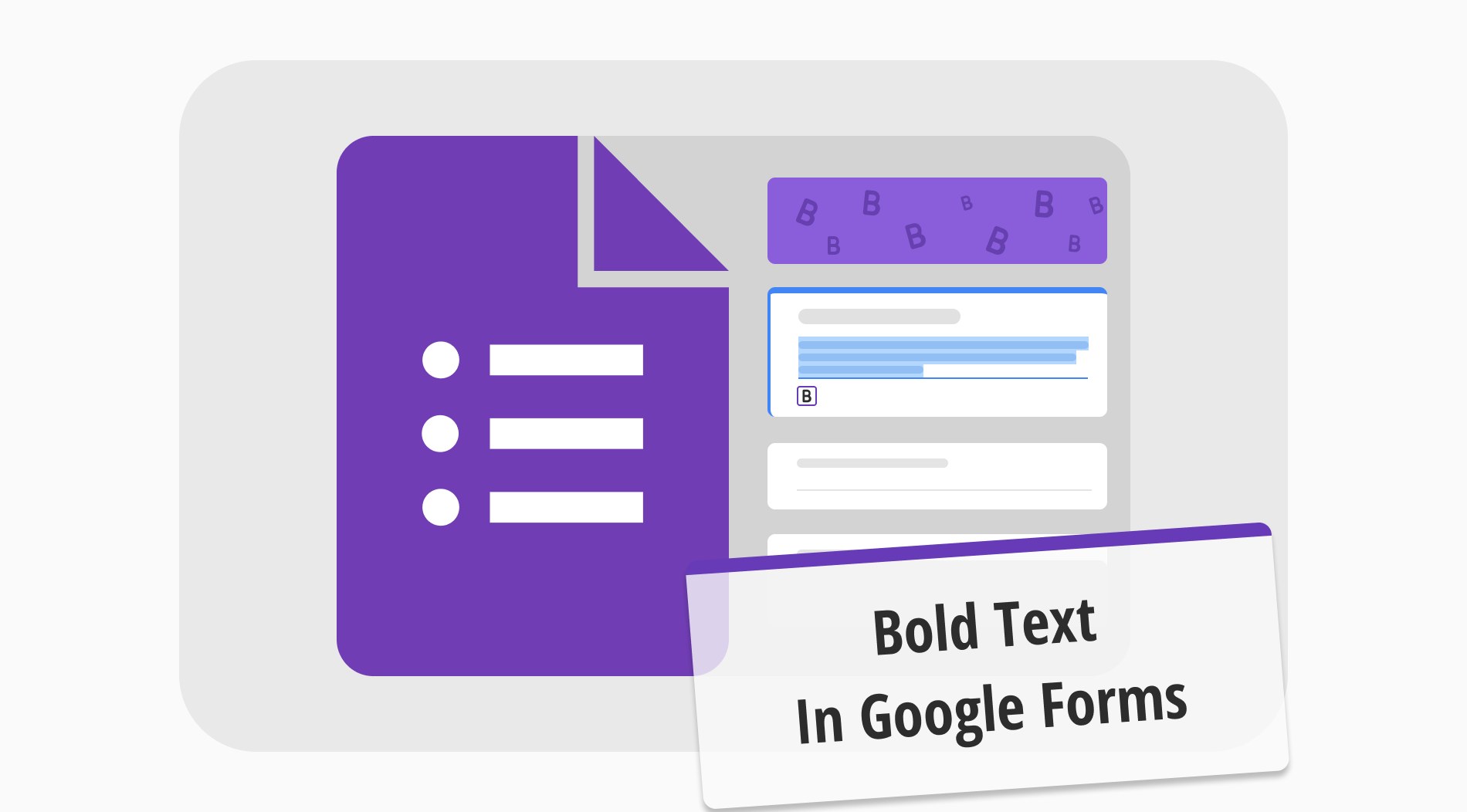
How to bold text in Google Forms (Step-by-step)
Yakup Ahenpençe

How to use images to make surveys more engaging (tips & tricks)

Investigación secundaria. El desk research
Como diseñadores de experiencia de usuario, nuestra misión es entender cómo el usuario se relaciona con nuestros productos y servicios, encontrar necesidades, problemas y puntos de dolor. Para ello podemos utilizar diferentes metodologías y a su vez tipos de fuentes como la investigación primaria y la investigación secundaria.
En este post veremos las diferencias entre ambas, cómo realizar un desk research y algunas fuentes de investigación de consumo que suelo consultar.
Definición investigación primaria y secundaria

Dentro de nuestras investigaciones las finalidades pueden ser varias;
- Entender la experiencia dentro de nuestro servicio
- Detectar nuevas necesidades con la intención de hacer crecer nuestra propuesta de valor
- Entender el marco actual en el que se encuentra es decir; el mercado, las nuevas tendencias tecnologías, económicas y sociales en las que se ve rodeado.
A la hora de investigar podemos obtener información de diferentes fuentes, las primarias y las secundarias.
Fuentes primarias
Las fuentes primarias son aquellas que recopilan datos de primera mano directamente de los usuarios o clientes a través de la investigación de campo o la observación. Esta fuente de información incluye encuestas, entrevistas, grupos focales y pruebas de usabilidad.
Las ventajas de las fuentes primarias son que proporcionan datos específicos y detallados sobre los usuarios y sus necesidades. Además, las fuentes primarias proporcionan una gran cantidad de información sobre la experiencia del usuario en tiempo real, lo que puede ser muy útil para identificar oportunidades de mejora.
Sin embargo, las fuentes primarias también pueden ser costosas y requieren mucho tiempo. Además, puede ser difícil encontrar la muestra adecuada de usuarios para una investigación determinada. Para hacer una correcta captación os recomiendo el siguiente recurso que podéis encontrar en este blog 👉 Plantilla reclutamiento de usuarios.
Fuentes secundarias
Las fuentes secundarias son aquellas que ya han sido recopiladas por terceros para otros propósitos y se utilizan como datos secundarios en un proyecto. Esta fuente de información incluye informes de investigación, estadísticas gubernamentales, artículos de prensa, y publicaciones especializadas.
Las ventajas de las fuentes secundarias son que proporcionan una gran cantidad de información con una inversión de tiempo y dinero relativamente baja. Además, estas fuentes de información son útiles para obtener una comprensión más amplia del mercado y el contexto en el que se encuentra el proyecto.
Sin embargo, las fuentes secundarias también tienen limitaciones. No siempre son tan específicas o detalladas como las fuentes primarias, y puede ser difícil identificar la calidad de la información. Por lo tanto, es importante evaluar la calidad y la confiabilidad de las fuentes secundarias antes de utilizarlas en un proyecto.
2. Hacer un desk research en 5 pasos

Paso 1: Definir el objetivo de la investigación
Antes de comenzar cualquier investigación, es importante tener claro el objetivo de la misma. Define qué quieres investigar y qué preguntas esperas responder.
Por ejemplo, si estás diseñando una aplicación móvil de compras en online, podrías definir el objetivo de la investigación como ‘entender las tendencias y patrones de compra en online para identificar oportunidades de mejora en la experiencia de usuario’.
Paso 2: Identificar las fuentes de información
Una vez que tengas claro el objetivo de la investigación, es hora de identificar las fuentes de información que te ayudarán a obtener los datos necesarios. Estas fuentes pueden incluir informes de investigación de mercado, publicaciones especializadas, artículos de prensa y estadísticas oficiales. Haz una lista de todas las que puedan ser relevantes.
Paso 3: Recopilar y revisar la información
El siguiente paso es recopilar la información y revisarla para identificar los datos relevantes. Esto puede implicar la lectura de informes completos o el escaneo de artículos para encontrar información relevante. También puedes utilizar herramientas de búsqueda en línea para encontrar información específica.
Paso 4: Analizar y sintetizar la información
Una vez que hayas recopilado la información necesaria, es hora de analizarla y sintetizarla. Identifica las tendencias y patrones en los datos, y busca información que pueda ser relevante para el objetivo de tu investigación. Agrupa la información en categorías relevantes para facilitar su análisis.
Paso 5: Informar y compartir los resultados
El último paso es informar y compartir los resultados de tu desk research. Crea un informe que incluya un resumen de los datos recopilados, las tendencias y patrones identificados, y cualquier otra información relevante. Asegúrate de que el informe sea fácil de leer y que contenga visualizaciones de datos cuando sea necesario. Comparte el informe con el equipo de diseño y cualquier otra persona que pueda estar interesada en los resultados.
Cuándo hacer un desk research

El desk research es útil en diversas situaciones, como:
Investigación preliminar: Antes de emprender un estudio más extenso, el desk research puede proporcionar una visión general del tema y ayudar a definir el alcance de la investigación.
Actualización de información: Mantenerse al día con los últimos avances y cambios en un campo específico.
Investigaciones económicas: Recopilar datos sobre mercados, competidores y tendencias industriales.
Pros y contras del desk research
Costo y tiempo: Es más económico y rápido que la investigación de campo, ya que no requiere recursos adicionales para la recopilación de datos.
Amplia cobertura : Permite acceder a una gran cantidad de información de diversas fuentes en poco tiempo.
Fácil acceso: La información en línea y en bibliotecas es generalmente de fácil acceso y disponible para cualquier investigador.
Limitaciones en la profundidad: No siempre proporciona datos detallados o en tiempo real, lo que puede ser un inconveniente para ciertas investigaciones.
Fiabilidad de fuentes: La calidad y precisión de la información pueden variar según la fuente, lo que requiere verificar la credibilidad de cada una.
Sesgo de información: Algunas fuentes pueden presentar sesgos o información parcial, lo que puede afectar la objetividad de los resultados.

Fuentes para investigación secundaria
TC Analysis: https://tcanalysis.com/insights
Thinking with google : https://www.thinkwithgoogle.com/intl/es-es/
Nielsen: https://www.nielsen.com/es/insights/
BBVA Research: https://www.bbvaresearch.com/topic/consumo/
World Data Bank: http://databank.bancomundial.org/data/home.aspx
Pew Research Center: http://www.pewsocialtrends.org/
Centro de Investigaciones Sociológicas: http://www.cis.es/
Gartner: http://gartner.com/
El benchmark VS desk research

El benchmark
El benchmark es una técnica de investigación que implica comparar el rendimiento de un producto o servicio con el de otros productos o servicios similares en el mercado. Esta técnica se utiliza para comprender las mejores prácticas de la industria y para identificar oportunidades de mejora en el diseño de productos y servicios. El objetivo del benchmark es obtener información sobre las características y funcionalidades que son importantes para los usuarios y que pueden ser adoptadas para mejorar el producto o servicio que se está diseñando.
El benchmark se lleva a cabo mediante la comparación directa de los productos o servicios similares en el mercado. Esta comparación puede incluir la revisión de documentación y la realización de pruebas para identificar las fortalezas y debilidades de cada producto o servicio. El benchmark se utiliza comúnmente para evaluar productos o servicios como sitios web, aplicaciones móviles, software y hardware.
Enfoque comparativo: El benchmarking implica comparar el rendimiento, las prácticas o los estándares de una organización con los de otras organizaciones líderes en la misma industria o en una industria similar.
Enfoque práctico: Se trata de un proceso práctico que busca identificar las mejores prácticas y las estrategias exitosas implementadas por otras empresas u organizaciones.
Enfoque en el rendimiento: El benchmarking se centra en medir y comparar el rendimiento en términos de eficiencia, efectividad y calidad.
Puede ser específico: Puede ser específico para un área determinada, como el benchmarking de procesos, el benchmarking de productos, etc.
Involucra contacto con otras organizaciones: A menudo implica interactuar con otras organizaciones, compartir información y aprender de sus experiencias para mejorar el propio rendimiento.
El desk reseach
Como hemos visto a diferencia del benchmark, el desk research no implica una comparación directa con otros productos o servicios similares en el mercado. En su lugar, se utiliza para obtener información sobre las tendencias del mercado, las necesidades y deseos de los usuarios, y las características y funcionalidades que son importantes para ellos.
Enfoque de investigación: El desk research es una forma de investigación que se basa en recopilar y analizar información ya existente, como informes, documentos, estadísticas y otros recursos disponibles.
Enfoque pasivo: Implica analizar datos y fuentes secundarias sin interactuar directamente con las fuentes originales de la información.
Puede ser más amplio: La investigación de escritorio puede abarcar una variedad de temas y áreas sin necesidad de limitarse a comparaciones directas con otras organizaciones.
Fuentes de datos: Se basa en fuentes de datos secundarios, como libros, revistas, informes, bases de datos en línea, etc.
Puede ser realizado individualmente: La investigación de escritorio puede ser llevada a cabo por una persona o un equipo de investigación sin necesariamente requerir interacción con otras organizaciones.
En resumen, el benchmarking se centra en comparar el rendimiento y las prácticas entre organizaciones para identificar mejores prácticas y mejorar el propio rendimiento, mientras que la investigación de escritorio se basa en recopilar y analizar información existente para obtener una comprensión más profunda de un tema sin necesariamente involucrar la comparación directa con otras organizaciones. Ambos enfoques tienen su propio propósito y pueden ser útiles en diferentes situaciones.
- Investigación primaria y secundaria
- Como hacer un desk research
- Informes especializados
- El desk research VS benchmark
Artículos Relacionados

No Comments
Sorry, the comment form is closed at this time.
Privacy Overview
- Desk Research: Definition, Types, Application, Pros & Cons

If you are looking for a way to conduct a research study while optimizing your resources, desk research is a great option. Desk research uses existing data from various sources, such as books, articles, websites, and databases, to answer your research questions.
Let’s explore desk research methods and tips to help you select the one for your research.
What Is Desk Research?
Desk research, also known as secondary research or documentary research, is a type of research that relies on data that has already been collected and published by others. Its data sources include public libraries, websites, reports, surveys, journals, newspapers, magazines, books, podcasts, videos, and other sources.
When performing desk research, you are not gathering new information from primary sources such as interviews, observations, experiments, or surveys. The information gathered will then be used to make informed decisions.
The most common use cases for desk research are market research , consumer behavior , industry trends , and competitor analysis .
How Is Desk Research Used?
Here are the most common use cases for desk research:
- Exploring a new topic or problem
- Identifying existing knowledge gaps
- Reviewing the literature on a specific subject
- Finding relevant data and statistics
- Analyzing trends and patterns
- Evaluating competitors and market trends
- Supporting or challenging hypotheses
- Validating or complementing primary research
Types of Desk Research Methods
There are two main types of desk research methods: qualitative and quantitative.
- Qualitative Desk Research
Analyzing non-numerical data, such as texts, images, audio, or video. Here are some examples of qualitative desk research methods:
Content analysis – Examining the content and meaning of texts, such as articles, books, reports, or social media posts. It uses data to help you identify themes, patterns, opinions, attitudes, emotions, or biases.
Discourse analysis – Studying the use of language and communication in texts, such as speeches, interviews, conversations, or documents. It helps you understand how language shapes reality, influences behavior, constructs identities, creates power relations, and more.
Narrative analysis – Analyzing the stories and narratives that people tell in texts, such as biographies, autobiographies, memoirs, or testimonials. This allows you to explore how people make sense of their experiences, express their emotions, construct their identities, or cope with challenges.
- Quantitative Desk Research
Analyzing numerical data, such as statistics, graphs, charts, or tables.
Here are common examples of quantitative desk research methods:
Statistical analysis : This method involves applying mathematical techniques and tools to numerical data, such as percentages ratios, averages, correlations, or regressions.
You can use statistical analysis to measure, describe, compare, or test relationships in the data.
Meta-analysis : Combining and synthesizing the results of multiple studies on a similar topic or question. Meta-analysis can help you increase the sample size, reduce the margin of error, or identify common findings or discrepancies in data.
Trend analysis : This method involves examining the changes and developments in numerical data over time, such as sales, profits, prices, or market share. It helps you identify patterns, cycles, fluctuations, or anomalies.
Examples of Desk Research
Here are some real-life examples of desk research questions:
- What are the current trends and challenges in the fintech industry?
- How do Gen Z consumers perceive money and financial services?
- What are the best practices for conducting concept testing for a new fintech product?
- Documentary on World War II and its effect on Austria as a country
You can use the secondary data sources listed below to answer these questions:
Industry reports and publications
- Market research surveys and studies
- Academic journals and papers
- News articles and blogs
- Podcasts and videos
- Social media posts and reviews
- Government and non-government agencies
How to Choose the Best Type of Desk Research
The main factors for selecting a desk research method are:
- Research objective and question
- Budget and deadlines
- Data sources availability and accessibility.
- Quality and reliability of data sources
- Your data analysis skills
Let’s say your research question requires an in-depth analysis of a particular topic, a literature review may be the best method. But if the research question requires analysis of large data sets, you can use trend analysis.
Differences Between Primary Research and Desk Research
The main difference between primary research and desk research is the source of data. Primary research uses data that is collected directly from the respondents or participants of the study. Desk research uses data that is collected by someone else for a different purpose.
Another key difference is the cost and time involved. Primary research is usually more expensive, time-consuming, and resource-intensive than desk research. However, it can also provide you with more specific, accurate, and actionable data that is tailored to your research goal and question.
The best practice is to use desk-based research before primary research; it refines the scope of the work and helps you optimize resources.
Read Also – Primary vs Secondary Research Methods: 15 Key Differences
How to Conduct a Desk Research
Here are the four main steps to conduct desk research:
- Define Research Goal and Question
What do you want to achieve with your desk research? What problem do you want to solve or what opportunity do you want to explore? What specific question do you want to answer with your desk research?
- Identify and Evaluate Data Sources
Where can you find relevant data for your desk research? How relevant and current are the data sources for your research? How consistent and comparable are they with each other?
You can evaluate your data sources based on factors such as-
– Authority: Who is the author or publisher of the data source? What are their credentials and reputation? Are they experts or credible sources on the topic?
– Accuracy: How accurate and precise is the data source? Does it contain any errors or mistakes? Is it supported by evidence or references?
– Objectivity: How objective and unbiased is the data source? Does it present facts or opinions? Does it have any hidden agenda or motive?
– Coverage: How comprehensive and complete is the data source? Does it cover all aspects of your topic? Does it provide enough depth and detail?
– Currency: How current and up-to-date is the data source? When was it published or updated? Is it still relevant to your topic?
- Collect and Analyze Your Data
How can you collect your data efficiently and effectively? What tools or techniques can you use to organize and analyze your data? How can you interpret your data with your research goal and question?
- Present and Report Your Findings
How can you communicate your findings clearly and convincingly? What format or medium can you use to accurately record your findings?
You can use spreadsheets, presentation slides, charts, infographics, and more.
Advantages of Desk Research
- Cost Effective
It is cheaper and faster than primary research, you don’t have to collect new data or report them. You can simply analyze and leverage your findings to make deductions.
- Prevents Effort Duplication
Desk research provides you with a broad and thorough overview of the research topic and related issues. This helps to avoid duplication of efforts and resources by using existing data.
- Improves Data Validity
Using desk research, you can compare and contrast various perspectives and opinions on the same topic. This enhances the credibility and validity of your research by referencing authoritative sources.
- Identify Data Trends and Patterns
It helps you to identify new trends and patterns in the data that may not be obvious from primary research. This can help you see knowledge and research gaps to offer more effective solutions.
Disadvantages of Desk Research
- Outdated Information
One of the main challenges of desk research is that the data may not be relevant, accurate, or up-to-date for the specific research question or purpose. Desk research relies on data that was collected for a different reason or context, which may not match the current needs or goals of the researcher.
- Limited Scope
Another limitation of desk research is that it may not provide enough depth or insight into qualitative aspects of the market, such as consumer behavior, preferences, motivations, or opinions.
Data obtained from existing sources may be biased or incomplete due to the agenda or perspective of the source.
Read More – Research Bias: Definition, Types + Examples
- Data Inconsistencies
It may also be inconsistent or incompatible with other data sources due to different definitions or methodologies.
- Legal and Technical Issues
Desk research data may also be difficult to access or analyze due to legal, ethical, or technical issues.
How to Use Desk Research Effectively
Here are some tips on how to use desk research effectively:
- Define the research problem and objectives clearly and precisely.
- Identify and evaluate the sources of secondary data carefully and critically.
- Compare and contrast different sources of data to check for consistency and reliability.
- Use multiple sources of data to triangulate and validate the findings.
- Supplement desk research with primary research when exploring deeper issues.
- Cite and reference the sources of data properly and ethically.
Desk research should not be used as a substitute for primary research, but rather as a complement or supplement. Combine it with primary research methods, such as surveys, interviews, observations, experiments, and others to obtain a more complete and accurate picture of your research topic.
Desk research is a cost-effective tool for gaining insights into your research topic. Although it has limitations, if you choose the right method and carry out your desk research effectively, you will save a lot of time, money, and effort that primary research would require.

Connect to Formplus, Get Started Now - It's Free!
- desk research
- market research
- primary vs secondary research
- research bias
- secondary research
- Moradeke Owa

You may also like:
25 Research Questions for Subscription Pricing
After strategically positioning your product in the market to generate awareness and interest in your target audience, the next step is...

Projective Techniques In Surveys: Definition, Types & Pros & Cons
Introduction When you’re conducting a survey, you need to find out what people think about things. But how do you get an accurate and...
Judgmental Sampling: Definition, Examples and Advantages
Introduction Judgment sampling is a type of non-random sampling method used in survey research and data collection. It is a method in...
What is Thematic Analysis & How to Do It
Introduction Thematic Analysis is a qualitative research method that plays a crucial role in understanding and interpreting data. It...
Formplus - For Seamless Data Collection
Collect data the right way with a versatile data collection tool. try formplus and transform your work productivity today..

- Investigación de Mercados
Guía completa en 5 pasos para hacer Desk Research
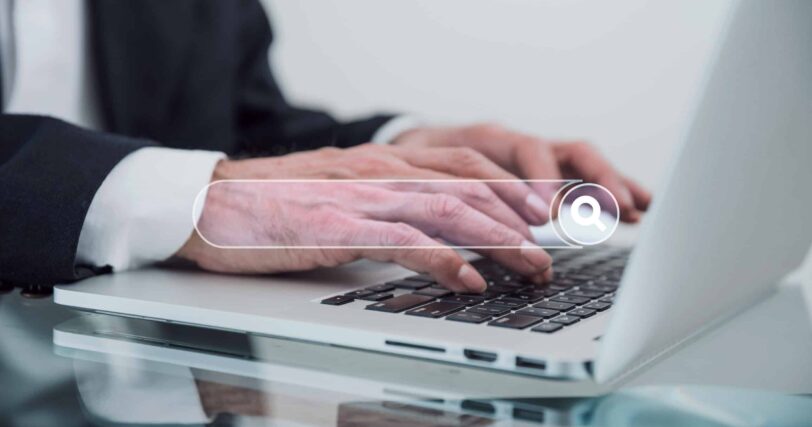
- Patricia Manero
- noviembre 22, 2022
- 0 comentarios
Desk research, algunos métodos y ejemplos de investigación
Identificar el tema de investigación, fuentes de información, recopilación de datos existentes, combinación y comparación, análisis de datos.
Desk research o investigación de escritorio es un método de investigación que implica el uso de datos que ya existen. Estos datos se recopilan y resumen en función de aumentar la eficacia general de la investigación.
En la actualidad, hay cientos de usuarios que dejan su huella digital en la red y cientos de empresas que buscan dar uso a estos datos para alcanzar sus objetivos. La investigación de escritorio o desk research se volvió uno de los métodos más utilizados, ya que se basa en material publicado en informes y documentos similares que se encuentran disponibles en bibliotecas públicas, sitios web, datos obtenidos de encuestas ya realizadas, entre otros.
Desk research es una opción popular para las empresas y organizaciones, pues no todas pueden pagar mucho dinero para investigación y recopilación de datos. Entonces, la investigación de escritorio puede rescatar y recopilar la información y data necesaria en diversas fuentes.
- Búsqueda en Internet
Los datos recopilados en la web son prácticamente gratuitos o, tal vez hay que pagar una pequeña cantidad por ellos. Los sitios web tienen mucha información que las empresas pueden utilizar para satisfacer sus necesidades de investigación. Sin embargo, se necesita considerar un sitio web confiable para recopilar información.
- Organizaciones gubernamentales y no gubernamentales
Ya sean agencias gubernamentales o no gubernamentales, la desk research siempre se valdrá de ellas para recopilar y comparar los datos para una investigación. Una empresa podrá, por ejemplo, saber cuáles son las áreas de oportunidad en el sector financiero al investigar cuáles son las principales quejas hacia la industria.
- Bibliotecas
Para una investigación de escritorio, siempre será necesario saber qué se ha dicho del tema en cuestión. En este sentido, las bibliotecas -ya sean digitales o de acervo- ayudarán a los investigadores a conocer el estado de las cosas con, por ejemplo, estadísticas de investigación, boletines informativos y las estrategias de comunicación a lo largo de un periodo.
- Instituciones educativas
Las instituciones de educación pueden dar a las organizaciones un sinfín de datos relevantes para llevar a cabo estudios e investigación de mercado. Una universidad, por ejemplo, puede darle a las empresas datos sobre cuáles son las motivaciones para estudiar determinada carrera o cuáles son los nuevos métodos de comunicación entre generaciones.
- Fuentes comerciales
Periódicos, revistas, estaciones de radio y televisión son una gran fuente de datos para el desk research, pues muestran la evolución económica, la agenda política, de mercado y la segmentación demográfica.
Guía para hacer un desk research
La investigación documental o secundaria ayudará a las empresas y organizaciones a recopilar información general y prepararse para la investigación cualitativa de usuarios.
Siguiendo esta línea, si se desea conocer el tamaño del mercado y los ingresos potenciales, será útil conocer soluciones existentes, así como definir grupos de usuarios y clientes potenciales. La investigación documental será una herramienta de investigación que ayudará a esto.
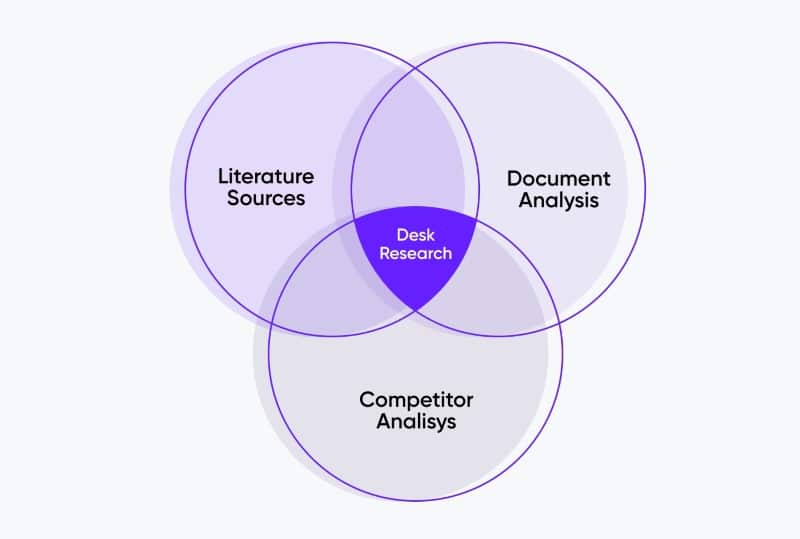
Para llevar a cabo un desk research, es necesario seguir los siguientes cinco pasos:
Antes de comenzar, es necesario identificar el tema que se va a investigar. Una vez hecho esto, es clave hacer una lista de los atributos de la investigación y su propósito.
El problema de investigación es la base de todo proceso, algo que necesita ser explicado. Para establecerlo y diseñar un proceso de investigación de mercados es necesario ser claro, concreto, y delimitar el espacio donde se desarrolla.
Este punto refiere a las fuentes de información que proporcionarán los datos más relevantes aplicables a la investigación.
Se pueden consultar informes gubernamentales o del sector privado, actas de congresos, publicaciones periódicas, publicaciones oficiales, artículos en periódicos y revistas.
Una vez que las fuentes de recolección de información estén reducidas, es clave verificar si hay datos anteriores disponibles que estén relacionados con la investigación. Pueden obtenerse de diversas fuentes como las anteriormente mencionadas.
Las referencias pueden ser registradas en las denominadas "tarjetas de Insights", las cuales contarán con un título que resuma la información, una breve descripción de la información, la fuente y la fecha de la investigación.
Una vez que se lleva a cabo la recopilación de los datos, combinarlos y compararlos es esencial para la eficiencia de la investigación. Esto para que no se duplique la información y se analice información dos veces.
Para esto, también destacan las tarjetas de insights, pues la restricción de espacio de la tarjeta induce a la objetividad en función de registrar lo que realmente tiene sentido del dato encontrado.
Este paso es, probablemente, el más relevante en la guía para hacer un desk research. En este punto, todos los anteriores cobran sentido, pues es aquí donde se confirma si se han respondido todas las preguntas del paso uno. Si no es así, el proceso se repite en función de profundizar más en ideas prácticas.
Siguiendo esta línea, el objetivo de este punto es realizar un seguimiento de los cambios durante todo el período. Se analizan, por ejemplo, registros, registros de correo electrónico, bases de datos, análisis web, actas de reuniones, informes del personal o registros de información.
Desk research es la opción para aquellas empresas que están dispuestas a realizar investigación de mercado sin necesidad de desembolsar grandes cantidades de dinero. Al ser, la mayoría, fuentes de libre acceso y fáciles de encontrar, la investigación secundaria ayudará a recopilar y utilizar los datos realmente necesarios, a diferencia de una investigación primaria que inicia desde cero.
Desk research , Herramientas de investigación , Investigación de Mercados
Editado Por: Patricia Manero
Mis conocimientos en redacción, análisis de texto, lingüística y literatura han ayudado al equipo de trabajo a generar contenidos de calidad. Feminista, comprometida con la sociedad, amante de los animales y de escribir.

Ultimos Artículos
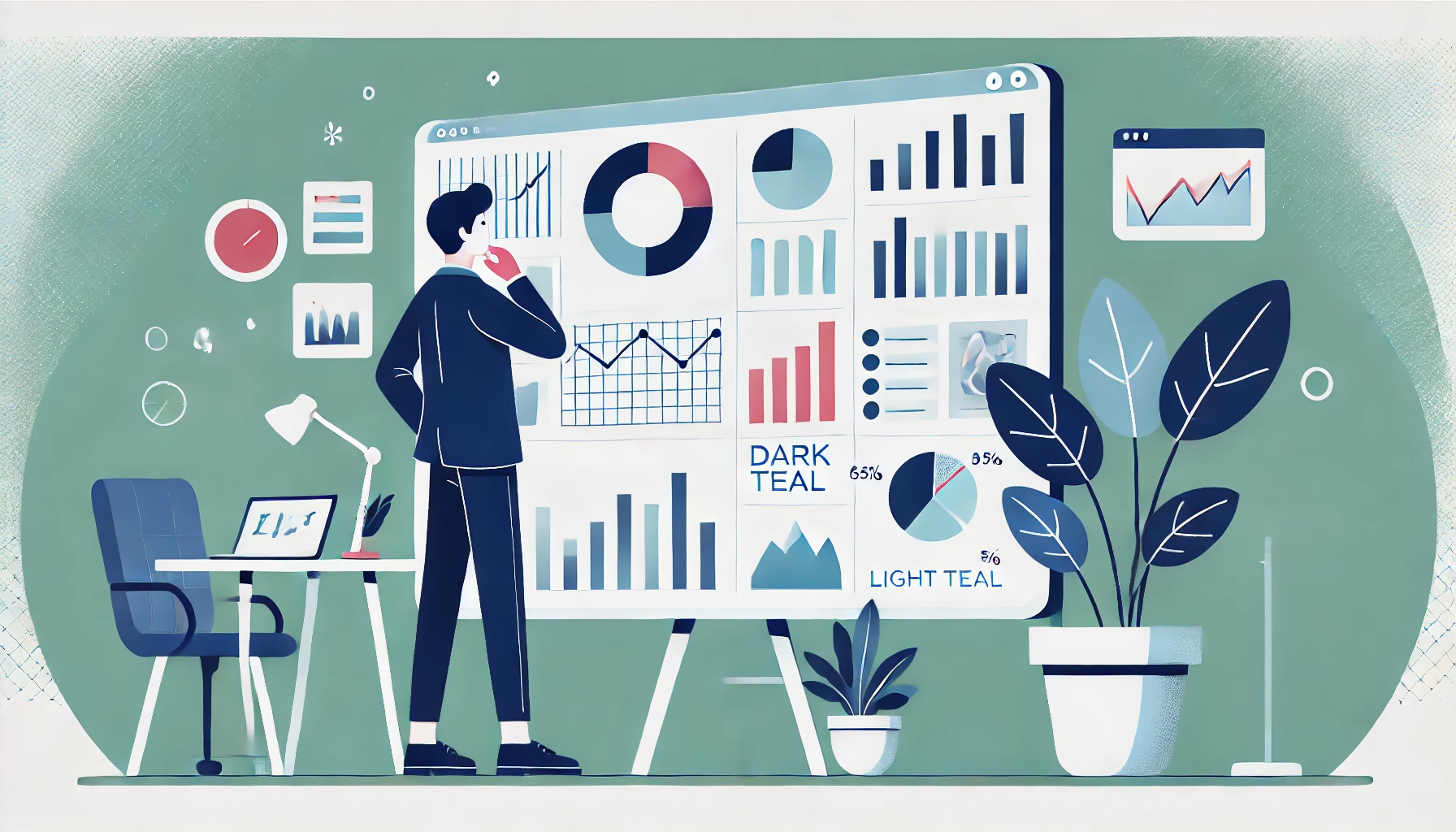
Análisis descriptivo: conoce sus fundamentos y aplicaciones en la investigación de mercados
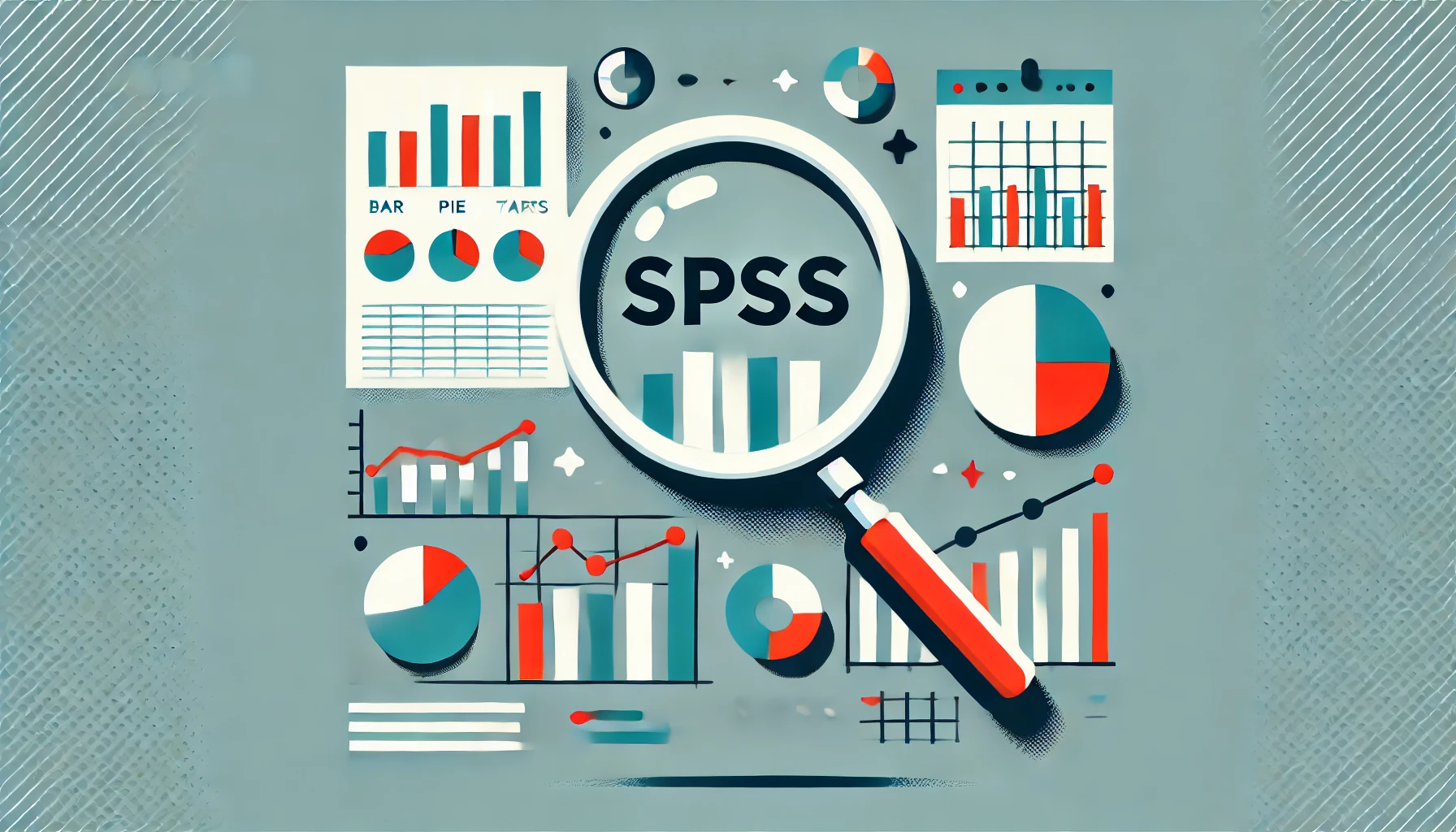
El futuro de SPSS en la estadística: ¿está siendo reemplazado en 2024?

Estrategias de ventas a nivel nacional: cómo maximizar la participación en el mercado para el éxito corporativo en 2024
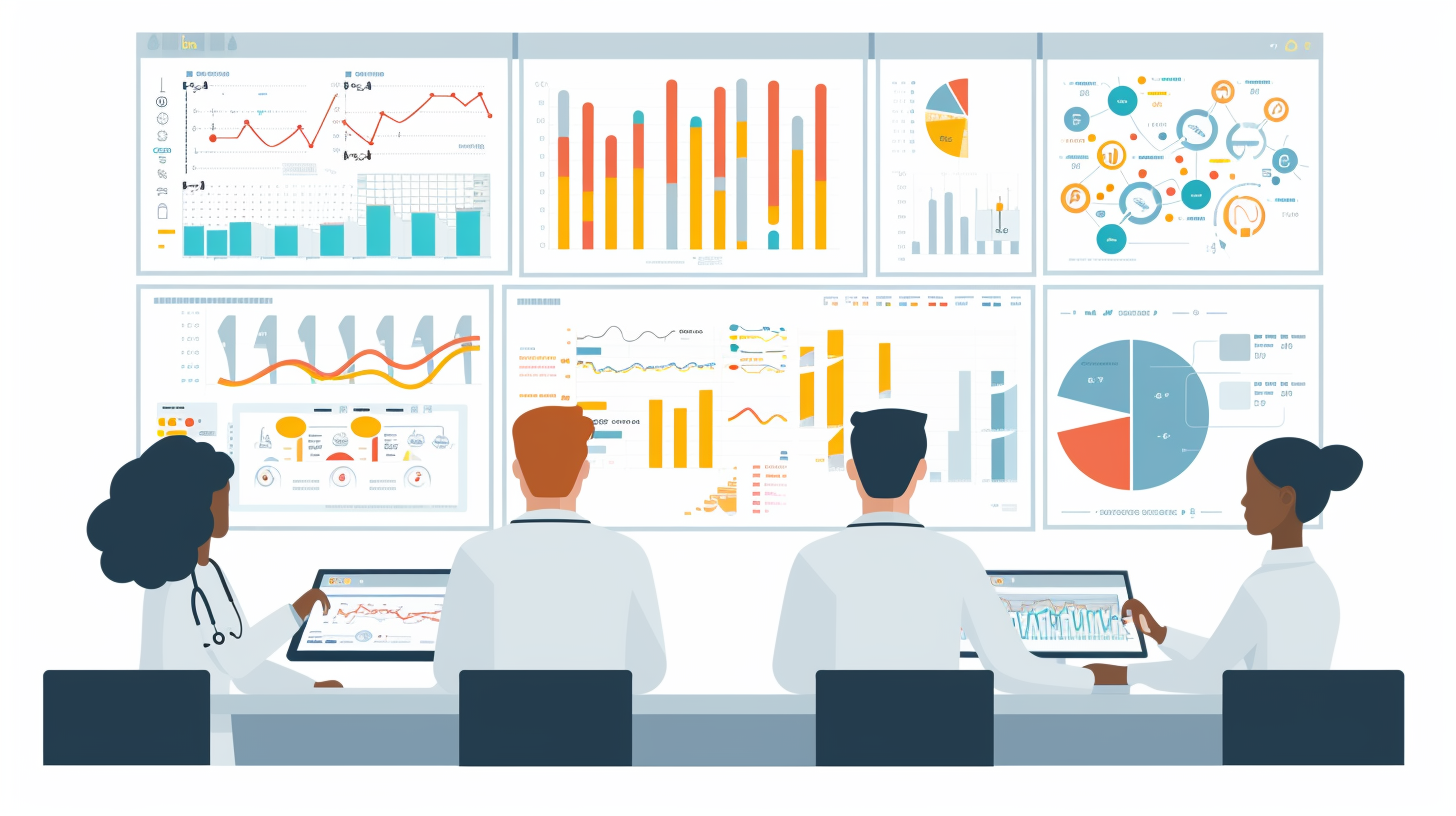
Maximizando el valor de los datos: estrategias para una recopilación de datos estadísticos exitosa en 2024

¿Crear encuestas gratuitas en 2024? Cuáles son sus pros y contras
Artículos más vistos.

Social Listening 10 cosas que necesitas saber

Buyer Persona: qué es y cómo hacerlo en 5 pasos

Mercado meta; ¿Qué es y por qué utilizarlo?

Muebles para el hogar y arquitectura, categorías al alza en 2022
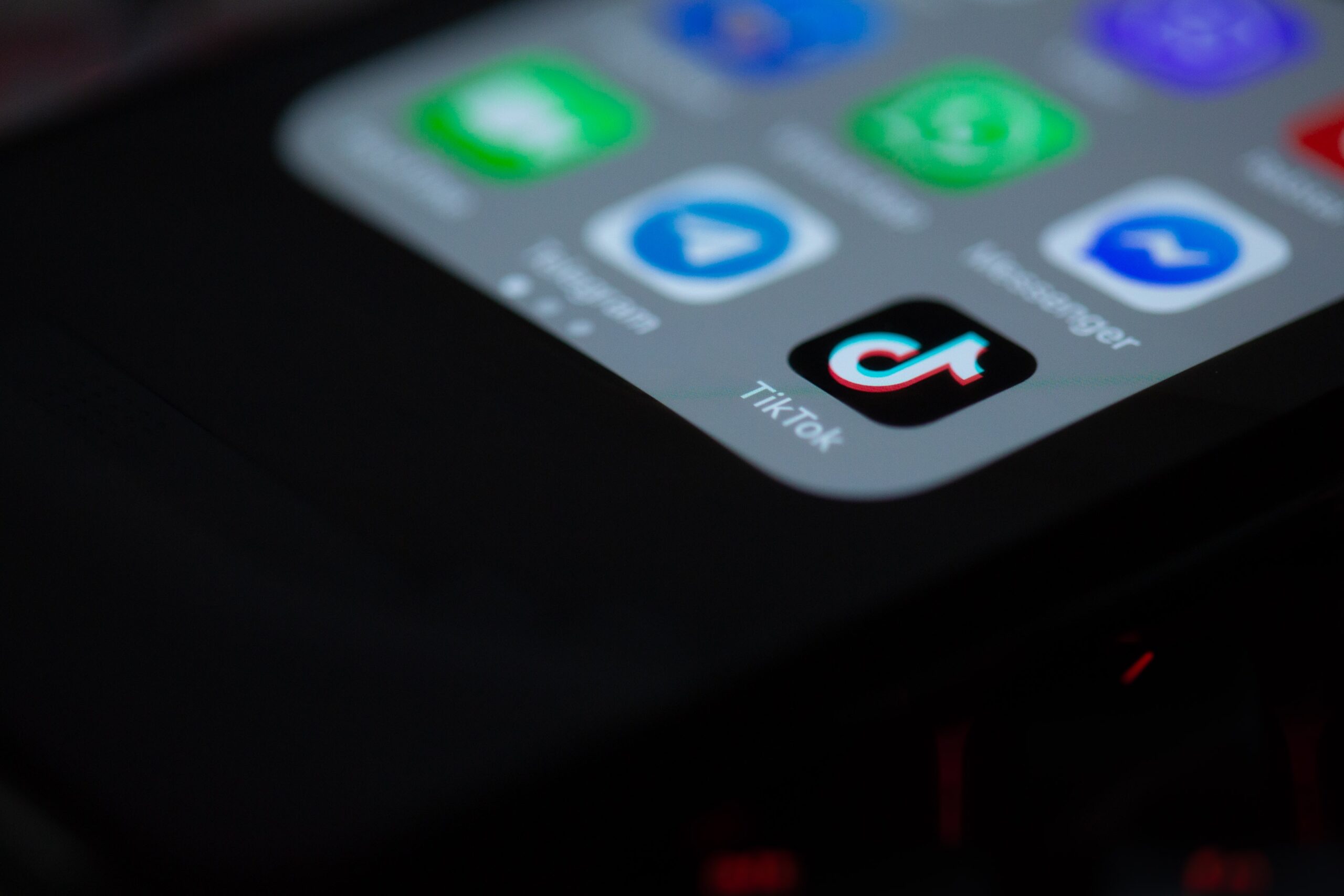
Patrón asociativo de las marcas con “Music for a Sushi Restaurant”
Desk Research

La metodología de investigación documental es un método de recopilación y análisis de información procedente de fuentes secundarias disponibles, como documentos, informes, publicaciones académicas y otros materiales disponibles en línea o en bibliotecas. El objetivo de la investigación documental es obtener una perspectiva más amplia del problema o la cuestión que se investiga y completar o confirmar los conocimientos sobre el tema. La investigación documental es especialmente útil para la investigación de acontecimientos o procesos históricos y la investigación teórica.
Aplicación de la investigación documental
Los métodos para llevar a cabo una investigación documental incluyen diversas formas de recopilar y analizar la información de mercado disponible sin realizar una investigación cara a cara con los usuarios. He aquí algunos ejemplos: Análisis de informes y publicaciones del sector disponibles: se pueden recopilar datos de informes y publicaciones del sector disponibles, como informes de mercado, análisis del sector, informes científicos, etc. Análisis de datos estadísticos: se pueden utilizar los datos estadísticos disponibles, como datos demográficos, datos de ventas, datos del mercado laboral, etc. Revisión de sitios web y portales del sector: se pueden recopilar datos de diversos sitios web y portales del sector, como los de fabricantes, distribuidores, organizaciones del sector, etc. Análisis de artículos periodísticos: puede analizar artículos periodísticos publicados en periódicos, revistas y en Internet para obtener información sobre el mercado y sus tendencias. Búsqueda en Internet: puede buscar información sobre el mercado utilizando motores de búsqueda como Google para obtener una amplia gama de información disponible. Análisis de datos de redes sociales: puede recopilar y analizar datos de redes sociales como Facebook, Twitter, Instagram, etc. para obtener información sobre las opiniones y preferencias de los usuarios.

Métodos de investigación documental
Los métodos para llevar a cabo la investigación documental son los siguientes: Búsqueda en bases de datos: Se pueden utilizar diversas bases de datos, como las industriales, estadísticas o científicas, para encontrar la información necesaria. Consulta de documentos e informes: Para obtener información sobre un tema de interés, también se pueden revisar diversos tipos de documentos e informes, como informes financieros, estadísticas de mercado o informes industriales. Analizar datos de Internet: También puedes utilizar diversas fuentes disponibles en internet, como páginas web, foros online o redes sociales para encontrar la información que necesitas. Investigación bibliográfica: También puede llevar a cabo una investigación bibliográfica, es decir, puede analizar la literatura científica disponible y hojear artículos de revistas científicas o libros de su campo. Análisis de datos de otras fuentes: También puedes utilizar datos disponibles de otras fuentes, como archivos de datos de oficinas o instituciones gubernamentales o datos recopilados por otras empresas u organizaciones.

Nuestra empresa Fieldstat está especializada en investigación documental. Ofrecemos el más alto nivel de servicio y nuestros equipos están cualificados profesionalmente. Realizamos estudios de mercado, estudios de calidad de productos, estudios de competencia, estudios de consumidores, estudios de medios sociales, estudios tecnológicos y mucho más. Disponemos de una gran cantidad de herramientas y conocimientos para satisfacer las necesidades de nuestros clientes y ofrecer los mejores resultados. Si busca a alguien que le ayude a recopilar e interpretar información, póngase en contacto con nosotros.
¿Quién encarga la investigación documental?
La investigación documental la encargan diversas personas o instituciones que necesitan información sobre un tema o mercado concreto. Ejemplos de personas o instituciones que pueden encargar un desk research: Empresas: Muchas empresas encargan desk research para conocer la situación del mercado, las necesidades y preferencias de los clientes, la competencia o las tendencias del sector. Organizaciones sin ánimo de lucro: Las organizaciones sin ánimo de lucro, como fundaciones o asociaciones, suelen encargar desk research para obtener información sobre un campo o tema social concreto. Instituciones gubernamentales: las instituciones gubernamentales, como ministerios u oficinas, también pueden encargar estudios documentales para obtener información sobre diversos temas, por ejemplo, para desarrollar políticas públicas. Particulares: Los particulares también pueden encargar una investigación documental, por ejemplo, si desean conocer el mercado de un servicio o producto para tomar una decisión de compra o inversión.
Vía de cooperación
Hablemos de su proyecto.
Valoramos su tiempo. Utilice el botón de la parte inferior para ponerse en contacto con nosotros sobre su proyecto de investigación.

Desk Research en la investigación UX
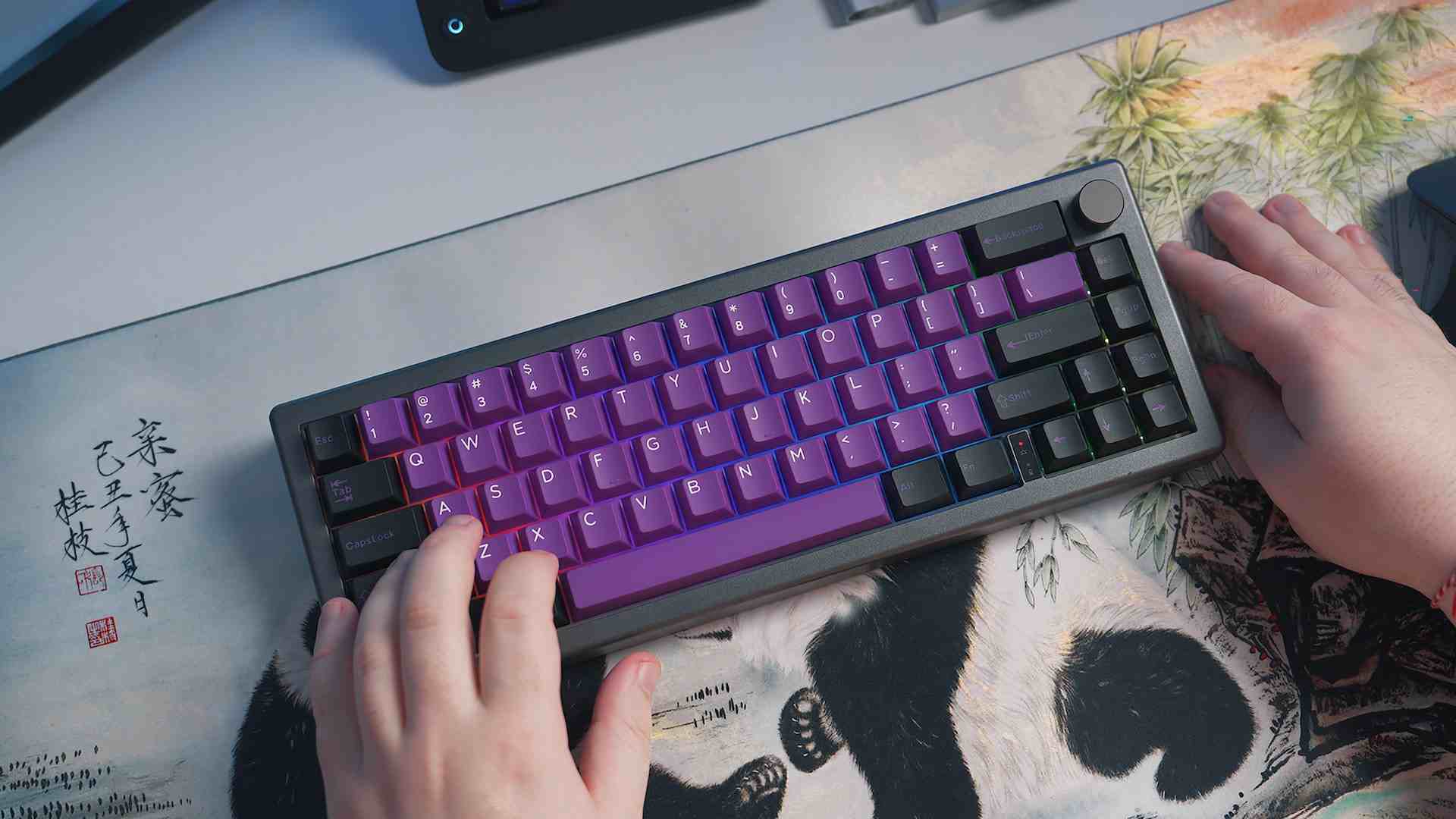
En la era digital, donde la interacción entre las personas y la tecnología es cada vez más frecuente, el diseño centrado en las personas usuarias se ha vuelto fundamental para el éxito de cualquier producto o servicio. La Experiencia de Usuario (UX) se enfoca en comprender las necesidades, expectativas y comportamientos de los usuarios, con el objetivo de crear soluciones que sean intuitivas, efectivas y satisfactorias.
Para lograr una buena UX, es necesario llevar a cabo investigaciones exhaustivas que permitan comprender a fondo a los usuarios y sus contextos. Una de las estrategias utilizadas en esta fase de investigación es el Desk Research , también conocido como investigación de escritorio, investigación bibliográfica o investigación de fuentes secundarias. A diferencia de la investigación de campo, el Desk Research se basa en el análisis y la recopilación de información existente , sin la necesidad de interactuar directamente con los usuarios.
¡Vamos a mostrarte que es el Desk Research en profundidad y cómo puedes usarlo a tu favor!
¿Qué es el Desk Research?
El Desk Research es una técnica de investigación en el campo de la experiencia de usuario que se basa en la recopilación y el análisis de información existente . A diferencia de otras metodologías que requieren interacciones directas con los usuarios, el Desk Research se centra en el estudio de fuentes secundarias, como estudios de mercado, informes de investigación, publicaciones académicas y bases de datos online.
Esta técnica permite a los profesionales de UX obtener conocimientos valiosos sobre los usuarios, sus necesidades, comportamientos y preferencias, así como sobre las mejores prácticas de diseño y las tendencias del mercado. Al recopilar y sintetizar la información relevante, el Desk Research proporciona una base sólida para la toma de decisiones informadas y la generación de ideas innovadoras en el proceso de diseño de productos y servicios centrados en el usuario.
Pero, ¿cómo se hace el Desk Research?
Hacer un Desk Research en UX implica recopilar información existente sobre un tema o problema específico sin realizar una investigación primaria o recopilar datos nuevos. Esta técnica es útil para obtener una comprensión inicial del contexto, los usuarios y las mejores prácticas antes de embarcarse en un proyecto de diseño o investigación de usuarios más profundo. Estos son los pasos clave para llevar a cabo un desk research de la forma correcta:
- Definir los objetivos de investigación : Antes de comenzar, es importante tener claridad sobre qué aspectos de la experiencia del usuario deseas investigar. Define tus objetivos de investigación y las preguntas que deseas responder.
- Identificar fuentes de información : Busca fuentes confiables de información relacionada con el tema de investigación. Esto puede incluir libros, artículos académicos, informes de mercado, estudios de casos, estadísticas, blogs especializados y otros recursos en línea.
- Realizar búsquedas online : Utiliza motores de búsqueda, como Google, para encontrar información relevante. Utiliza palabras clave relacionadas con tu tema y examina los resultados de búsqueda para identificar artículos, informes u otros recursos relevantes.
- Revisar bibliografía y referencias : Cuando encuentres un recurso relevante, revisa la bibliografía y las referencias citadas en ese recurso. Esto te permitirá encontrar otros estudios y fuentes relacionadas que podrían ser útiles para tu investigación.
- Explorar comunidades online : Las comunidades online, como foros y grupos de discusión especializados, pueden ser una fuente valiosa de información. Explora comunidades relevantes relacionadas con UX y busca discusiones o preguntas que se relacionen con tu investigación.
- Analizar y sintetizar la información : A medida que recopiles información de diversas fuentes, analiza y sintetiza los hallazgos clave. Busca patrones, tendencias o temas recurrentes que te ayuden a comprender mejor el problema o el contexto de tu investigación.
- Documentar y compartir los resultados : Registra todos los hallazgos y conclusiones en un documento o informe. Asegúrate de citar adecuadamente las fuentes de información utilizadas. Comparte los resultados con tu equipo, stakeholders o cualquier persona relevante que pueda beneficiarse de la información recopilada.
Ventajas del Desk Research
La práctica de esta técnica de investigación lleva consigo varias ventajas para aquellos que lo practican. Estas son las ventajas del Desk Research más relevantes:
- Acceso a información existente : El Desk Research permite aprovechar la amplia cantidad de información ya disponible. Puedes acceder a libros, artículos, informes de investigación, estudios de caso y otros recursos que abordan temas relacionados con la UX. Esto te brinda la oportunidad de aprender de la experiencia y el conocimiento acumulado por otros profesionales y expertos en el campo.
- Ahorro de tiempo y recursos : Al no requerir la realización de una investigación primaria o la recopilación de datos nuevos, es una forma eficiente de obtener información. Puedes aprovechar los recursos ya existentes en lugar de dedicar tiempo y esfuerzo a realizar investigaciones más extensas y costosas. Esto es especialmente útil en situaciones en las que se tiene un marco de tiempo ajustado o recursos limitados, y como primera fase del proceso de investigación UX..
- Amplia perspectiva : Al revisar una variedad de fuentes de información, puedes obtener una perspectiva amplia sobre el tema o problema de UX que estás investigando. Esto te permite obtener una comprensión más completa de los diferentes enfoques, teorías y prácticas que existen en el campo. Esta perspectiva amplia puede inspirar nuevas ideas y enfoques para tus proyectos de diseño y mejora de la experiencia del usuario.
- Identificación de mejores prácticas : Permite identificar y aprender de las mejores prácticas en UX. Puedes descubrir casos de estudio exitosos, investigaciones relevantes y ejemplos de diseño que han demostrado ser efectivos en la mejora de la experiencia del usuario. Esta información puede servir como base para tus propios proyectos de diseño, ayudándote a tomar decisiones informadas y a evitar posibles errores.
- Complemento a la investigación primaria : Aunque el Desk Research no reemplaza la investigación primaria y la recopilación de datos directos de los usuarios, puede servir como un complemento valioso. Puede ayudarte a establecer un contexto inicial, identificar lagunas de conocimiento y generar preguntas específicas para investigaciones posteriores. Puede proporcionar una base sólida para diseñar estudios de usuarios más enfocados y significativos
En definitiva, el desk Research en UX es una técnica valiosa que permite acceder a información existente, ahorrar tiempo y recursos, obtener una perspectiva amplia, identificar mejores prácticas y complementar la investigación primaria.
¿Quieres darnos tu impresión sobre este post?
Deja una respuesta
Aquí va tu texto personalizado.
Comentario *

Claves para un buen UX writing
-Torresburriel Estudio
El UX Writing, conocido como “el arte de diseñar con palabras”, es una práctica muy utilizada en el diseño de productos digitales. Se trata de crear textos que faciliten la interacción de los usuarios con...

Barreras de accesibilidad en aplicaciones bancarias
La accesibilidad en las aplicaciones bancarias no se trata solo de cumplir con las leyes. Es algo que es necesario para que todo el mundo, independientemente de sus capacidades, pueda gestionar su dinero. Ver también:...

UX en dispositivos múltiples: accesibilidad y rendimiento
Los dispositivos que utilizamos y llevamos encima son ya una extensión de nosotros mismos. Y, como bien dice Don Norman, “la buena UX es invisible”. Esto quiere decir que cuando no nos enteremos de los...

- Resumen de privacidad
- Cookies estrictamente necesarias
Esta web utiliza cookies para que podamos ofrecerte la mejor experiencia de usuario posible. La información de las cookies se almacena en tu navegador y realiza funciones tales como reconocerte cuando vuelves a nuestra web o ayudar a nuestro equipo a comprender qué secciones de la web encuentras más interesantes y útiles.
Las cookies estrictamente necesarias tiene que activarse siempre para que podamos guardar tus preferencias de ajustes de cookies.
Si desactivas esta cookie no podremos guardar tus preferencias. Esto significa que cada vez que visites esta web tendrás que activar o desactivar las cookies de nuevo.
Desk research
What is it and how do you conduct it properly, deskresearch.
- Research method
View our services

Language check
Have your thesis or report reviewed for language, structure, coherence, and layout.

Plagiarism check
Check if your document contains plagiarism.

APA-generator
Create your reference list in APA style effortlessly. Completely free of charge.
What is desk research?
Desk research vs. literature reviews, desk research as a research method, how do you properly tackle desk research, where do you find information for desk research.
Desk research means that you use previously collected data for your research instead of collecting it yourself. You answer your research question based on the existing data you analyze. This might include previous literature, company information, or other available data. What exactly is desk research and how do you conduct it properly?
When you do desk research, you collect existing data and use it to learn more about your research topic. You are not collecting quantitative or qualitative data yourself through things like surveys, interviews or observations.
In desk research, you work with secondary data (data collected by someone else). In field research, on the other hand, you work with primary data (data you collected yourself).
Desk research is an especially relevant research method if a lot of information on a topic is already available and/or if it is difficult to collect this data yourself. This type of research is less appropriate if you are one of the first to research the topic.
Often the terms "desk research" and "literature review" are used interchangeably. However, they don't mean exactly the same thing.
A literature review (also called "narrative review") is designed to gain more theoretical knowledge about a topic.
In desk research you collect existing research results or factual results in order to use them to explain a certain phenomenon. In doing so, you often answer an explanatory research question. You investigate a possible connection between variables.
You can use desk research as a research method on its own in your thesis. Your entire thesis research will then consist of desk research. In that case, you describe the results of the desk research in the results chapter. In the method chapter you explain how you approached the research.
It is also possible for you to use desk research as a stepping stone to a study that you will conduct yourself with data you have collected yourself. You arrive at hypotheses or theories through desk research that you then test through your own data collection. When you use desk research in this way, you incorporate its results into the theoretical framework. This type of research is called deduction .
You can also use desk research to supplement, for example, surveys, interviews , an experiment, or observations. In these cases, desk research can help explain the results you found.
If you are going to conduct desk research, you need to go through a number of stages to do so. For example, it is important that you select the right sources and report on the sources in a logical way. To do this, take the following steps:
Determine appropriate search terms. First, determine what search terms you will use to find sources through, for example, your educational institution's online library or Google Scholar. Often, you will use terms that appear in your problem statement or research question. Search for English search terms and any other languages you may want to include.
Find appropriate sources. You do this with the chosen search terms, but also, for example, by looking in the list of found sources. Perhaps there is another useful source cited by one of the articles you read through. Save all sources in one convenient folder and put them in your bibliography so you don’t forget them.
Determine which sources are relevant. Not all sources found are equally relevant to your topic. You also want to avoid having so many sources that you cannot see the forest for the trees. Check whether the sources you have found actually match your problem, research question, and research goal. Also check the reliability of the source. Ideally you should mostly use sources from leading journals and from authors who are affiliated with a scientific institute.
Incorporate the sources you found into your text. Are you doing a quantitative analysis? If so, you will first use SPSS or Excel. Are you referring verbatim to content from the sources? Then it's mainly a matter of putting relevant content together correctly in your thesis. Make sure you create a logical thread, for example by discussing sources by topic or in chronological order.
Review the bibliography. Make sure all sources from your desk research are correctly listed in the bibliography. Also, check the source citation. Make sure your sources are formatted in APA style (or the source citation style that applies to your course).
The sources you use must be relevant and reliable. You cannot use sources like Wikipedia. In terms of sources, consider, for example:
scholarly articles (which you can find through Google Scholar and your university or college's online library, among others);
statistics from organizations such as the Central Bureau of Statistics or other reputable research institutions;
LexisNexis: a database of newspapers where you can find all kinds of news sources;
reliable databases within your field;
collections published with an academic publisher;
annual reports or corporate reports;
reports from other agencies;
literature;
documents from archives;
reports from the municipality, for example;
photographs or art objects.
Sometimes you can use very different types of sources for your research. For example, are you doing research on Instagram posts? Then, of course, you can collect existing Instagram posts on social media for that purpose and they count as sources.
Getting your sources checked
For desk research you often use a large number of sources. Unfortunately, it is easy to make an error when citing your sources. Do you want to prevent errors from creeping in unnoticed? Have your sources checked by one of our editors. They will review every source manually and ensure that all sources are correctly listed in your bibliography.
- Cambridge Dictionary +Plus
Meaning of desk research in English
Your browser doesn't support HTML5 audio
- all-you-can-eat
- anti-consumer
- anti-dumping
- distribution channel
- do business with someone/something
- economic activity
- pre-emption
- procurement
- rewards card
- the bottom drops/falls out of the market idiom
You can also find related words, phrases, and synonyms in the topics:
desk research | Business English
Examples of desk research, translations of desk research.
Get a quick, free translation!

Word of the Day
out of harm's way
in a position that is safe from harm or from which harm cannot be done

Trial, judge, and jury: talking about what happens when a criminal is caught

Learn more with +Plus
- Recent and Recommended {{#preferredDictionaries}} {{name}} {{/preferredDictionaries}}
- Definitions Clear explanations of natural written and spoken English English Learner’s Dictionary Essential British English Essential American English
- Grammar and thesaurus Usage explanations of natural written and spoken English Grammar Thesaurus
- Pronunciation British and American pronunciations with audio English Pronunciation
- English–Chinese (Simplified) Chinese (Simplified)–English
- English–Chinese (Traditional) Chinese (Traditional)–English
- English–Dutch Dutch–English
- English–French French–English
- English–German German–English
- English–Indonesian Indonesian–English
- English–Italian Italian–English
- English–Japanese Japanese–English
- English–Norwegian Norwegian–English
- English–Polish Polish–English
- English–Portuguese Portuguese–English
- English–Spanish Spanish–English
- English–Swedish Swedish–English
- Dictionary +Plus Word Lists
- English Noun
- Business Noun
- Translations
- All translations
To add desk research to a word list please sign up or log in.
Add desk research to one of your lists below, or create a new one.
{{message}}
Something went wrong.
There was a problem sending your report.
Desk Research: Uma Ferramenta Valiosa para Profissionais de Pesquisa de Mercado
Entenda o que é uma desk research, como fazer uma e como ela pode ser útil nas suas estratégias.

Como chegar a soluções de desafios complexos que você enfrenta na sua empresa partindo de respostas básicas que já foram respondidas — e o melhor: que já estão disponíveis? Com a ajuda de uma desk research bem-feita.
A desk research, também conhecida como pesquisa secundária, é a coleta e análise de informações já disponíveis em diversos meios : na internet, em revisões bibliográficas, bancos de dados, pesquisas acadêmicas e de mercado, estatísticas, artigos científicos, entre outros.
Ela funciona de forma diferente da pesquisa primária, que envolve a coleta direta de dados por meio de entrevistas, questionários, observações, entre outras metodologias.
A desk research é feita a partir do aproveitamento de dados e informações existentes, sendo uma facilitadora para que profissionais de pesquisa de mercado obtenham informações valiosas, de forma eficiente e econômica, e dêem o ponto de partida para seus projetos de pesquisa. Neste artigo, vamos te mostrar como fazer e como a desk research pode ajudar no seu dia a dia.
Para que serve uma desk research?
Entendido que desk research é uma espécie de pesquisa de mesa, tenha em mente que ela serve como uma base inicial para resolver problemas de pesquisas mais complexas.
Essa ferramenta ajuda a compreender melhor o cenário que você está investigando e a planejar melhor as suas estratégias, seja para investir em um estudo mais completo, seja para compreender os caminhos possíveis.
Se você quiser saber, por exemplo, quantos brasileiros consumiram suplementos alimentares no país em 2022, é bem provável que essa informação esteja disponível na internet — e essa informação pode fazer parte da sua desk research.
Porém, se você precisa analisar mais a fundo e descobrir se o seu público é consumidor de suplementos alimentares será preciso investir em novos estudos, mais completos e feitos a partir dessa primeira análise.
Aqui, uma pesquisa de mercado , feita exclusivamente para resolver o seu problema de negócio entrará em cena.
Como profissionais de pesquisa podem usar uma desk research?
A desk research pode ser uma ferramenta poderosa para profissionais de pesquisa de mercado e aqui estão algumas das principais aplicações ou iniciativas que podem ser implementadas a partir dos seus dados:
1. Compreender um mercado
A desk research permite que os profissionais de pesquisa obtenham uma visão abrangente do mercado (ou da indústria) em que uma empresa opera.
Ao analisar relatórios de mercado, estudos setoriais e dados estatísticos, é possível identificar tendências, padrões de consumo, tamanho do mercado, os principais concorrentes e certas oportunidades de crescimento ou de atuação.
2. Conhecer o público-alvo
Ao realizar uma desk research, é possível obter informações detalhadas sobre o público-alvo de uma empresa. Dependendo do estudo, ele pode incluir características demográficas, preferências de consumo, comportamento de compra, identificar necessidades e desejos desses clientes.

Essas informações são essenciais para segmentar o mercado de forma eficaz e desenvolver estratégias de marketing direcionadas.
Os estudos originais da MindMiners são exemplos de pesquisas que podem compor a sua desk research, pois são detalhados, focados em diversidades demográficas e cheio de insights sobre o comportamento de diversos perfis de consumidores.
Na nossa página , você confere estudos sobre diversos temas: sexualidade, finanças, internet, pets, a relação das pessoas com as cidades, e muitos outros assuntos que podem ajudar as suas estratégias de comunicação e marketing.
3. Analisar a concorrência
A desk research oferece a oportunidade de estudar os concorrentes de uma empresa de perto. É possível analisar relatórios anuais, comunicados de imprensa, sites, redes sociais e outras fontes de informações para entender melhor as estratégias de negócios dos concorrentes.
Outros dados que podem ser coletados nesse sentido são suas ofertas de produtos e serviços, o posicionamento de mercado e as forças e fraquezas. Essa análise competitiva pode ajudar as empresas a identificar gaps, oportunidades de diferenciação e como planejar estratégias para sair na frente.
4. Apoiar a tomada de decisões estratégicas
Uma desk research bem-feita pode fornecer informações valiosas que, juntas, podem apoiar a tomada de decisões estratégicas na empresa.
Ao reunir dados e informações relevantes já disponíveis, os profissionais de pesquisa de mercado podem identificar lacunas para tomar ou apoiar as melhores decisões de negócio.
Quais os principais desafios ao realizar uma desk research?
Dissemos anteriormente que a pesquisa de dados secundários é uma forma econômica e eficiente de obter informações preliminares. Porém, justamente por existir esse vasto campo de dados disponíveis é que muitos profissionais de pesquisa e de marketing se veem receosos quanto à credibilidade dessas referências.
Esse é um questionamento plausível, afinal, existem muitas informações sem respaldo técnico, científico ou feitas sem aprofundamento ou bases concretas. No entanto, existem diversas formas de minimizar os riscos de coletar dados falsos ou que podem ser inúteis no final das contas. Adiante você verá dicas de como fazer isso.

Outro desafio dos profissionais que lidam com pesquisa é a dificuldade de encontrar essas informações. Pois saiba que elas existem, pelo menos dados mais básicos que ajudarão a começar a sua investigação mais profunda.
Empresas de pesquisa de mercado, como a MindMiners , sempre disponibilizam estudos e conteúdos diversos com dados reais e atualizados sobre um cenário que se pretende compreender.
Por isso, para ficar sempre por dentro, é importante seguir as páginas oficiais nas redes sociais e nos sites, e receber conteúdo diretamente no seu e-mail , por exemplo.
Como escolher as melhores fontes de dados para fazer uma desk research?
Portais oficiais dos órgãos especializados no assunto que você está pesquisando, pesquisas, revistas e artigos científicos, Portal da Transparência , IBGE , IPEA , boletins, anuários, o CNPQ e o portal Dados Abertos são apenas alguns exemplos de fontes confiáveis de informações que podem compor a sua desk research.
Porém, essas consultas vão depender de qual segmento você atua e deseja investigar e, principalmente, do objetivo da sua pesquisa. Por isso, a partir da definição do que se pretende pesquisar, tenha atenção a alguns passos:
- faça busca por palavras-chaves relacionadas ao tema do seu estudo;
- utilize mais de uma fonte de dados. Você pode, inclusive, fazer comparações entre elas;
- divida seu estudo em fases: a 1ª pode ser destinada a coleta das informações; a 2ª será para organização dos dados; e a 3ª para leitura e análise do que é mais interessante manter em sua pesquisa;
- questione os dados encontrados. Como dissemos, a pesquisa de dados secundários tem o objetivo de oferecer um cenário com informações iniciais e, em teoria, que sejam fáceis de serem coletadas, por isso, tendem a ser mais superficiais. O questionamento das informações e o entendimento de onde ir além é exatamente a expertise de quem trabalha com pesquisas.
Por fim, se você já realizou pesquisas antes, pode e deve aproveitar os dados que já foram coletados nessas pesquisas e utilizá-los para composição da sua desk research.
Inclusive, ao analisar de forma mais profunda os dados que já tem, muitas vezes, uma nova pesquisa com dados primários pode nem ser necessária. Eis o benefício da economia de tempo e esforço.
Mas se você já tem a sua desk research e precisa de dados mais completos, aprofundados e coletados especificamente para suas necessidades de negócio, o melhor caminho é investir em uma pesquisa de mercado, que pode ser feita até de forma autônoma e flexível por meio da plataforma da MindMiners.
Você pode testar gratuitamente por 15 dias e ver quantos insights pode coletar com a ferramenta. Ou se preferir, clique no banner abaixo e fale com um de nossos especialistas.

(crédito de capa: Sara Kurfeß )
Mercado Farmacêutico: o uso de medicamentos no Brasil
Data mining: transformando informações brutas em insights valiosos, a rotina de beleza do brasileiro: uma pesquisa sobre skincare e maquiagem.

Qual o melhor questionário da MindMiners para reduzir o seu churn rate
Saiba como criar um questionário para analisar churn da sua empresa e evitar que ele aumente.

O alimento que jogamos fora
Causas, consequências e soluções para uma prática insustentável: o desperdício de alimentos.
Programa de Yoga
El yoga es una práctica de salud integral que se ofrece a los pacientes del Children's Hospital of Philadelphia (CHOP). La palabra "yoga" significa "unión o unir". El yoga centra la atención en la respiración y el cuerpo al mismo tiempo, y su práctica puede mejorar la salud y el bienestar mediante posturas (asana), ejercicios de respiración (pranayama), relajación y meditación.
El yoga puede mejorar la flexibilidad, la fuerza y el equilibrio. Al adoptar posturas de yoga y prestar atención a la respiración, uno siente que está mejor conectado con su cuerpo. El yoga tiene muchos beneficios y puede practicarse durante toda la vida.
Yoga for Cancer Coping
La meditación forma parte del yoga y es una manera de tranquilizar la mente para que pueda centrarse en un pensamiento o imagen determinados, o en los sentidos, como el tacto o el olfato. Puede favorecer la relajación, el sueño y combatir la ansiedad. En CHOP, la meditación se ofrece a los pacientes de una forma apropiada para la edad y el nivel de desarrollo de cada niño.
Quiénes somos
El Programa de Yoga de CHOP está a cargo de terapeutas e instructores de yoga certificados con años de experiencia en el trabajo con niños y adolescentes que presentan diferentes problemas de salud.
La práctica del yoga es un complemento del tratamiento médico que brinda el equipo de atención médica de su hijo. Los terapeutas de yoga colaboran estrechamente con el equipo de atención médica.
Nuestro trabajo
El yoga se puede practicar en sesiones individuales o grupales.
Las sesiones de yoga se planifican en función de las necesidades y capacidades de cada niño. El equipo médico, el instructor de yoga, su hijo y la familia determinarán un plan para la práctica de yoga del niño.
Las sesiones de yoga pueden incluir:
- Ejercicios de respiración y relajación.
- Calentamiento físico.
- Posturas, movimientos o estiramientos de yoga.
- Meditación.
Las sesiones de yoga duran entre 25 y 60 minutos y varían en función de la edad, la salud y los intereses de cada niño. El número de sesiones dependerá de los síntomas y el interés de su hijo.
El yoga no sustituye al tratamiento médico. Consulte a su profesional de atención médica si desea obtener más información sobre el Programa de Yoga de CHOP o el Programa de Salud Integral . Nuestro personal puede ayudarle a decidir si la práctica de yoga podría complementar el plan de atención médica de su hijo.
Recursos adicionales
- Herramientas para conciliar el sueño: Respiración
- Herramientas integrales para el sueño: Yoga
- Herramientas de ayuda contra el estrés: Respiración
- Herramientas de ayuda contra el estrés: Relajación muscular progresiva
- Herramientas de ayuda contra el estrés: Yoga
- Serie de videos sobre la respiración terapéutica
- Video explicativo de la respiración profunda
- Integrative Medicine - Primary Care Perspectives Podcast [Episodio sobre la Medicina Integral]
Contact the Integrative Health

IMAGES
COMMENTS
Desk research o investigación de escritorio es un método para obtener información a través de datos existentes. Conoce las ventajas de su uso.
El Desk Research, también conocido como investigación secundaria o investigación de escritorio, es un tipo de investigación que se basa en fuentes de información publicadas en sitios webs, informes, libros, artículos, estadísticas, bases de datos, etc. El objetivo del Desk Research es recabar información relevante sobre el tema que se ...
Desk Research definition: Desk research, also known as secondary research or complementary research, involves gathering information and data from existing sources, such as books, journals, articles, websites, reports, and other published materials. Users analyze and synthesize information from already available information.
"Desk research" o investigación secundaria es el proceso de extraer y organizar información basada en fuentes existentes como informes, noticias o libros. ¿Te acuerdas de la enciclopedia Encarta? ¡Bingo! Es un ejemplo de fuente secundaria. ¿Cuándo y cómo incluimos esta investigación en nuestros proyectos?
What is desk research? Read a complete guide to desk-based research, including desk research methodology, examples, and tips for success.
El desk research, también conocido como investigación de escritorio o investigación documental, es una metodología de investigación que se basa en la recopilación y análisis de información existente y disponible en fuentes escritas, digitales y documentales. En lugar de realizar investigación de campo o recopilar datos de primera mano ...
Desk research is a type of research that is based on the material published in reports and similar documents that are available in public libraries, websites, data obtained from surveys already carried out, etc. Some organizations also store data that can be used for research purposes. It is a research method that involves the use of existing data.
Curious about desk research? You're doing it (without knowing it). Learn all about desk research with loads of examples and expert tips.
desk research significado, definición, qué es desk research: 1. market research (= finding out what customers want) that can be done from a desk, for example…. Saber más.
What is desk research? In layman's terms, desk research is a type of research where you gather data while " sitting at a desk ." It is another name for secondary research where the study itself is desk-based research and not experiment-based research. Broadly speaking, there are two types of main research types.
Como hacer un Desk Research o investigación de escritorio paso a paso. Fuentes que te ayudarán para este proceso.
Desk research, also known as secondary research or documentary research, is a type of research that relies on data that has already been collected and published by others. Its data sources include public libraries, websites, reports, surveys, journals, newspapers, magazines, books, podcasts, videos, and other sources.
Desk research o investigación de escritorio es un método de investigación que implica el uso de datos que ya existen. Estos datos se recopilan y resumen en función de aumentar la eficacia general de la investigación.
DE. Desk Research. La metodología de investigación documental es un método de recopilación y análisis de información procedente de fuentes secundarias disponibles, como documentos, informes, publicaciones académicas y otros materiales disponibles en línea o en bibliotecas. El objetivo de la investigación documental es obtener una ...
El Desk Research es una técnica de investigación en el campo de la experiencia de usuario que se basa en la recopilación y el análisis de información existente. A diferencia de otras metodologías que requieren interacciones directas con los usuarios, el Desk Research se centra en el estudio de fuentes secundarias, como estudios de mercado ...
Are you going o do desk research for your thesis? Read here about what desk research is and how to do it step by step, including an overview of reliable sources.
Estudio documental o desk research, también llamado investigación de gabinete. Un estudio documental o desk research es una técnica de investigación de mercado que consiste en recopilar información a partir de fuentes documentales y electrónicas para analizar y sintetizar los datos relevantes para un proyecto de investigación en particular.
El desk research se caracteriza por ser un tipo de investigación que no involucra mucha inversión, ya que la fuente de la información son datos que en algún momento se investigaron, como datos ...
A menudo se habla de que hay dos tipos de desk research, el interno y el externo. El desk research interno basa sus fuentes de información en la propia organización o en la información que proporciona el cliente de un proyecto. Por su parte, el desk research externo utiliza fuentes de información, como por ejemplo datos de tipo más estadístico y social (elaborados por organismos ...
desk research Significado, definición, qué es desk research: 1. market research (= finding out what customers want) that can be done from a desk, for example…. Aprender más.
DESK RESEARCH definition: 1. market research (= finding out what customers want) that can be done from a desk, for example…. Learn more.
A desk research, também conhecida como pesquisa secundária, é a coleta e análise de informações já disponíveis em diversos meios: na internet, em revisões bibliográficas, bancos de dados, pesquisas acadêmicas e de mercado, estatísticas, artigos científicos, entre outros. Ela funciona de forma diferente da pesquisa primária, que ...
El yoga es una práctica de salud integral que se ofrece a los pacientes del Children's Hospital of Philadelphia (CHOP). La palabra "yoga" significa "unión o unir". El yoga centra la atención en la respiración y el cuerpo al mismo tiempo, y su práctica puede mejorar la salud y el bienestar mediante posturas (asana), ejercicios de ...